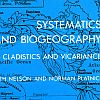| |
   
Mihaela Baroni,
Stefan Grünewald,
Vincent Moulton and
Charles Semple. Bounding the number of hybridization events for a consistent evolutionary history. In JOMB, Vol. 51(2):171-182, 2005.
Keywords: agreement forest, bound, explicit network, from rooted trees, hybridization, minimum number, phylogenetic network, phylogeny, reconstruction, SPR distance.
Note: http://www.math.canterbury.ac.nz/~c.semple/papers/BGMS05.pdf.
Toggle abstract
"Evolutionary processes such as hybridisation, lateral gene transfer, and recombination are all key factors in shaping the structure of genes and genomes. However, since such processes are not always best represented by trees, there is now considerable interest in using more general networks instead. For example, in recent studies it has been shown that networks can be used to provide lower bounds on the number of recombination events and also for the number of lateral gene transfers that took place in the evolutionary history of a set of molecular sequences. In this paper we describe the theoretical performance of some related bounds that result when merging pairs of trees into networks. © Springer-Verlag 2005."
|
|
| |
   
Magnus Bordewich,
Simone Linz,
Katherine St. John and
Charles Semple. A reduction algorithm for computing the hybridization number of two trees. In EBIO, Vol. 3:86-98, 2007.
Keywords: agreement forest, FPT, from rooted trees, hybridization, phylogenetic network, phylogeny, Program HybridNumber.
Note: http://www.math.canterbury.ac.nz/~c.semple/papers/BLSS07.pdf.
|
|
| |
 
Magnus Bordewich and
Charles Semple. On the computational complexity of the rooted subtree prune and regraft distance. In ACOM, Vol. 8:409-423, 2005.
Keywords: agreement forest, from rooted trees, NP complete, SPR distance.
Note: http://www.math.canterbury.ac.nz/~c.semple/papers/BS04.pdf.
Toggle abstract
"The graph-theoretic operation of rooted subtree prune and regraft is increasingly being used as a tool for understanding and modelling reticulation events in evolutionary biology. In this paper, we show that computing the rooted subtree prune and regraft distance between two rooted binary phylogenetic trees on the same label set is NP-hard. This resolves a longstanding open problem. Furthermore, we show that this distance is fixed parameter tractable when parameterised by the distance between the two trees."
|
|
| |
 
Magnus Bordewich and
Charles Semple. Computing the minimum number of hybridization events for a consistent evolutionary history. In DAM, Vol. 155:914-918, 2007.
Keywords: agreement forest, approximation, APX hard, explicit network, from rooted trees, hybridization, inapproximability, NP complete, phylogenetic network, phylogeny, SPR distance.
Note: http://www.math.canterbury.ac.nz/~c.semple/papers/BS06a.pdf.
|
|
| |
  
Mihaela Baroni,
Charles Semple and
Mike Steel. Hybrids in Real Time. In Systematic Biology, Vol. 55(1):46-56, 2006.
Keywords: agreement forest, from rooted trees, phylogenetic network, phylogeny, polynomial, reconstruction, time consistent network.
Note: http://www.math.canterbury.ac.nz/~m.steel/Non_UC/files/research/hybrids.pdf.
Toggle abstract
"We describe some new and recent results that allow for the analysis and representation of reticulate evolution by nontree networks. In particular, we (1) present a simple result to show that, despite the presence of reticulation, there is always a well-defined underlying tree that corresponds to those parts of life that do not have a history of reticulation; (2) describe and apply new theory for determining the smallest number of hybridization events required to explain conflicting gene trees; and (3) present a new algorithm to determine whether an arbitrary rooted network can be realized by contemporaneous reticulation events. We illustrate these results with examples. Copyright © Society of Systematic Biologists."
|
|
| |
   
Luay Nakhleh,
Tandy Warnow,
C. Randal Linder and
Katherine St. John. Reconstructing reticulate evolution in species - theory and practice. In JCB, Vol. 12(6):796-811, 2005.
Keywords: from rooted trees, galled tree, phylogenetic network, phylogeny, polynomial, Program SPNet, reconstruction, software.
Note: http://www.cs.rice.edu/~nakhleh/Papers/NWLSjcb.pdf.
|
|
| |
|
| |
 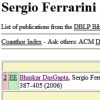 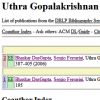 
Bhaskar DasGupta,
Sergio Ferrarini,
Uthra Gopalakrishnan and
Nisha Raj Paryani. Inapproximability results for the lateral gene transfer problem. In JCO, Vol. 11(4):387-405, 2006.
Keywords: approximation, from rooted trees, from species tree, inapproximability, lateral gene transfer, parsimony, phylogenetic network, phylogeny.
Note: http://www.cs.uic.edu/~dasgupta/resume/publ/papers/t-scenario-3-reviewed-3.pdf.
|
|
| |
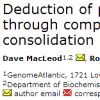 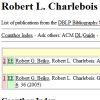  
Dave MacLeod,
Robert L. Charlebois,
W. Ford Doolittle and
Eric Bapteste. Deduction of probable events of lateral gene transfer through comparison of phylogenetic trees by recursive consolidation and rearrangement. In BMCEB, Vol. 5(27), 2005.
Keywords: explicit network, from rooted trees, lateral gene transfer, phylogenetic network, phylogeny, Program HorizStory, reconstruction, software.
Note: http://dx.doi.org/10.1186/1471-2148-5-27.
Toggle abstract
"Background: When organismal phylogenies based on sequences of single marker genes are poorly resolved, a logical approach is to add more markers, on the assumption that weak but congruent phylogenetic signal will be reinforced in such multigene trees. Such approaches are valid only when the several markers indeed have identical phylogenies, an issue which many multigene methods (such as the use of concatenated gene sequences or the assembly of supertrees) do not directly address. Indeed, even when the true history is a mixture of vertical descent for some genes and lateral gene transfer (LGT) for others, such methods produce unique topologies. Results: We have developed software that aims to extract evidence for vertical and lateral inheritance from a set of gene trees compared against an arbitrary reference tree. This evidence is then displayed as a synthesis showing support over the tree for vertical inheritance, overlaid with explicit lateral gene transfer (LGT) events inferred to have occurred over the history of the tree. Like splits-tree methods, one can thus identify nodes at which conflict occurs. Additionally one can make reasonable inferences about vertical and lateral signal, assigning putative donors and recipients. Conclusion: A tool such as ours can serve to explore the reticulated dimensionality of molecular evolution, by dissecting vertical and lateral inheritance at high resolution. By this, we mean that individual nodes can be examined not only for congruence, but also for coherence in light of LGT. We assert that our tools will facilitate the comparison of phylogenetic trees, and the interpretation of conflicting data. © 2005 MacLeod et al; licensee BioMed Central Ltd."
|
|
| |
 
Robert G. Beiko and
Nicholas Hamilton. Phylogenetic identification of lateral genetic transfer events. In BMCEB, Vol. 6(15), 2006.
Keywords: evaluation, from rooted trees, from unrooted trees, lateral gene transfer, Program EEEP, Program HorizStory, Program LatTrans, reconstruction, software, SPR distance.
Note: http://dx.doi.org/10.1186/1471-2148-6-15.
Toggle abstract
"Background: Lateral genetic transfer can lead to disagreements among phylogenetic trees comprising sequences from the same set of taxa. Where topological discordance is thought to have arisen through genetic transfer events, tree comparisons can be used to identify the lineages that may have shared genetic information. An 'edit path' of one or more transfer events can be represented with a series of subtree prune and regraft (SPR) operations, but finding the optimal such set of operations is NP-hard for comparisons between rooted trees, and may be so for unrooted trees as well. Results: Efficient Evaluation of Edit Paths (EEEP) is a new tree comparison algorithm that uses evolutionarily reasonable constraints to identify and eliminate many unproductive search avenues, reducing the time required to solve many edit path problems. The performance of EEEP compares favourably to that of other algorithms when applied to strictly bifurcating trees with specified numbers of SPR operations. We also used EEEP to recover edit paths from over 19 000 unrooted, incompletely resolved protein trees containing up to 144 taxa as part of a large phylogenomic study. While inferred protein trees were far more similar to a reference supertree than random trees were to each other, the phylogenetic distance spanned by random versus inferred transfer events was similar, suggesting that real transfer events occur most frequently between closely related organisms, but can span large phylogenetic distances as well. While most of the protein trees examined here were very similar to the reference supertree, requiring zero or one edit operations for reconciliation, some trees implied up to 40 transfer events within a single orthologous set of proteins. Conclusion: Since sequence trees typically have no implied root and may contain unresolved or multifurcating nodes, the strategy implemented in EEEP is the most appropriate for phylogenomic analyses. The high degree of consistency among inferred protein trees shows that vertical inheritance is the dominant pattern of evolution, at least for the set of organisms considered here. However, the edit paths inferred using EEEP suggest an important role for genetic transfer in the evolution of microbial genomes as well. © 2006Beiko and Hamilton; licensee BioMed Central Ltd."
|
|
| |
 
Maria S. Poptsova and
J. Peter Gogarten. The power of phylogenetic approaches to detect horizontally transferred genes. In BMCEB, Vol. 7(45), 2007.
Keywords: evaluation, from rooted trees, lateral gene transfer, Program EEEP.
Note: http://dx.doi.org/10.1186/1471-2148-7-45.
Toggle abstract
"Background. Horizontal gene transfer plays an important role in evolution because it sometimes allows recipient lineages to adapt to new ecological niches. High genes transfer frequencies were inferred for prokaryotic and early eukaryotic evolution. Does horizontal gene transfer also impact phylogenetic reconstruction of the evolutionary history of genomes and organisms? The answer to this question depends at least in part on the actual gene transfer frequencies and on the ability to weed out transferred genes from further analyses. Are the detected transfers mainly false positives, or are they the tip of an iceberg of many transfer events most of which go undetected by current methods? Results. Phylogenetic detection methods appear to be the method of choice to infer gene transfers, especially for ancient transfers and those followed by orthologous replacement. Here we explore how well some of these methods perform using in silico transfers between the terminal branches of a gamma proteobacterial, genome based phylogeny. For the experiments performed here on average the AU test at a 5% significance level detects 90.3% of the transfers and 91% of the exchanges as significant. Using the Robinson-Foulds distance only 57.7% of the exchanges and 60% of the donations were identified as significant. Analyses using bipartition spectra appeared most successful in our test case. The power of detection was on average 97% using a 70% cut-off and 94.2% with 90% cut-off for identifying conflicting bipartitions, while the rate of false positives was below 4.2% and 2.1% for the two cut-offs, respectively. For all methods the detection rates improved when more intervening branches separated donor and recipient. Conclusion. Rates of detected transfers should not be mistaken for the actual transfer rates; most analyses of gene transfers remain anecdotal. The method and significance level to identify potential gene transfer events represent a trade-off between the frequency of erroneous identification (false positives) and the power to detect actual transfer events. © 2007 Poptsova and Gogarten; licensee BioMed Central Ltd."
|
|
| |
|
| |
|
| |
   
Iyad A. Kanj,
Luay Nakhleh,
Cuong Than and
Ge Xia. Seeing the Trees and Their Branches in the Network is Hard. In TCS, Vol. 401:153-164, 2008.
Keywords: evaluation, from network, from rooted trees, NP complete, phylogenetic network, phylogeny, tree containment.
Note: http://www.cs.rice.edu/~nakhleh/Papers/tcs08.pdf.
|
|
| |
 
Roderic D.M. Page and
Michael A. Charleston. Trees within trees: phylogeny and historical associations. In TEE, Vol. 13(9):356-359, 1998.
Keywords: duplication, explicit network, from rooted trees, from species tree, lateral gene transfer, phylogenetic network, phylogeny, reconstruction, survey.
Note: http://taxonomy.zoology.gla.ac.uk/rod/papers/tree.pdf.
|
|
| |
   
Cuong Than,
Derek Ruths,
Hideki Innan and
Luay Nakhleh. Confounding Factors in HGT Detection: Statistical Error, Coalescent Effects, and Multiple Solutions. In JCB, Vol. 14(4):517-535, 2007.
Keywords: counting, explicit network, from rooted trees, from species tree, lateral gene transfer, phylogenetic network, phylogeny, Program LatTrans, Program PhyloNet.
Note: http://www.cs.rice.edu/~nakhleh/Papers/recombcg06-jcb.pdf.
|
|
| |

Stephen J. Willson. Regular Networks Can Be Uniquely Constructed from Their Trees. In TCBB, Vol. 8(3):785-796, 2010.
Keywords: explicit network, from rooted trees, phylogenetic network, phylogeny, reconstruction, regular network.
Note: http://www.public.iastate.edu/~swillson/RegularNetsFromTrees5.pdf.
Toggle abstract
"A rooted acyclic digraph N with labeled leaves displays a tree T when there exists a way to select a unique parent of each hybrid vertex resulting in the tree T. Let Tr(N) denote the set of all trees displayed by the network N. In general, there may be many other networks M, such that Tr(M) = Tr(N). A network is regular if it is isomorphic with its cover digraph. If N is regular and D is a collection of trees displayed by N, this paper studies some procedures to try to reconstruct N given D. If the input is D=Tr(N), one procedure is described, which will reconstruct N. Hence, if N and M are regular networks and Tr(N) = Tr(M), it follows that N = M, proving that a regular network is uniquely determined by its displayed trees. If D is a (usually very much smaller) collection of displayed trees that satisfies certain hypotheses, modifications of the procedure will still reconstruct N given D. © 2011 IEEE."
|
|
| |
 
Philippe Gambette and
Katharina Huber. On Encodings of Phylogenetic Networks of Bounded Level. In JOMB, Vol. 65(1):157-180, 2012.
Keywords: characterization, explicit network, from clusters, from rooted trees, from triplets, galled tree, identifiability, level k phylogenetic network, phylogenetic network, uniqueness, weak hierarchy.
Note: http://hal.archives-ouvertes.fr/hal-00609130/en/.
Toggle abstract
"Phylogenetic networks have now joined phylogenetic trees in the center of phylogenetics research. Like phylogenetic trees, such networks canonically induce collections of phylogenetic trees, clusters, and triplets, respectively. Thus it is not surprising that many network approaches aim to reconstruct a phylogenetic network from such collections. Related to the well-studied perfect phylogeny problem, the following question is of fundamental importance in this context: When does one of the above collections encode (i. e. uniquely describe) the network that induces it? For the large class of level-1 (phylogenetic) networks we characterize those level-1 networks for which an encoding in terms of one (or equivalently all) of the above collections exists. In addition, we show that three known distance measures for comparing phylogenetic networks are in fact metrics on the resulting subclass and give the diameter for two of them. Finally, we investigate the related concept of indistinguishability and also show that many properties enjoyed by level-1 networks are not satisfied by networks of higher level. © 2011 Springer-Verlag."
|
|
| |
  
Josh Voorkamp né Collins,
Simone Linz and
Charles Semple. Quantifying hybridization in realistic time. In JCB, Vol. 18(10):1305-1318, 2011.
Keywords: explicit network, FPT, from rooted trees, hybridization, minimum number, phylogenetic network, phylogeny, Program HybridInterleave, reconstruction, software.
Note: http://wwwcsif.cs.ucdavis.edu/~linzs/CLS10_interleave.pdf, software available at http://www.math.canterbury.ac.nz/~c.semple/software.shtml.
Toggle abstract
"Recently, numerous practical and theoretical studies in evolutionary biology aim at calculating the extent to which reticulation-for example, horizontal gene transfer, hybridization, or recombination-has influenced the evolution for a set of present-day species. It has been shown that inferring the minimum number of hybridization events that is needed to simultaneously explain the evolutionary history for a set of trees is an NP-hard and also fixed-parameter tractable problem. In this article, we give a new fixed-parameter algorithm for computing the minimum number of hybridization events for when two rooted binary phylogenetic trees are given. This newly developed algorithm is based on interleaving-a technique using repeated kernelization steps that are applied throughout the exhaustive search part of a fixed-parameter algorithm. To show that our algorithm runs efficiently to be applicable to a wide range of practical problem instances, we apply it to a grass data set and highlight the significant improvements in terms of running times in comparison to an algorithm that has previously been implemented. © 2011, Mary Ann Liebert, Inc."
|
|
| |
|
| |
|
| |
|
| |
|
| |
  
Simone Linz,
Charles Semple and
Tanja Stadler. Analyzing and reconstructing reticulation networks under timing constraints. In JOMB, Vol. 61(5):715-737, 2010.
Keywords: explicit network, from rooted trees, hybridization, lateral gene transfer, NP complete, phylogenetic network, phylogeny, reconstruction, time consistent network.
Note: http://dx.doi.org/10.1007/s00285-009-0319-y..
Toggle abstract
"Reticulation networks are now frequently used to model the history of life for various groups of species whose evolutionary past is likely to include reticulation events such as horizontal gene transfer or hybridization. However, the reconstructed networks are rarely guaranteed to be temporal. If a reticulation network is temporal, then it satisfies the two biologically motivated timing constraints of instantaneously occurring reticulation events and successively occurring speciation events. On the other hand, if a reticulation network is not temporal, it is always possible to make it temporal by adding a number of additional unsampled or extinct taxa. In the first half of the paper, we show that deciding whether a given number of additional taxa is sufficient to transform a non-temporal reticulation network into a temporal one is an NP-complete problem. As one is often given a set of gene trees instead of a network in the context of hybridization, this motivates the second half of the paper which provides an algorithm, called TemporalHybrid, for reconstructing a temporal hybridization network that simultaneously explains the ancestral history of two trees or indicates that no such network exists. We further derive two methods to decide whether or not a temporal hybridization network exists for two given trees and illustrate one of the methods on a grass data set. © 2009 The Author(s)."
|
|
| |
  
Ali Tofigh,
Mike Hallett and
Jens Lagergren. Simultaneous Identification of Duplications and Lateral Gene Transfers. In TCBB, Vol. 8(2):517-535, 2011.
Keywords: duplication, explicit network, FPT, from rooted trees, from species tree, lateral gene transfer, loss, NP complete, phylogenetic network, phylogeny, reconstruction.
Note: http://dx.doi.org/10.1109/TCBB.2010.14.
Toggle abstract
"The incongruency between a gene tree and a corresponding species tree can be attributed to evolutionary events such as gene duplication and gene loss. This paper describes a combinatorial model where so-called DTL-scenarios are used to explain the differences between a gene tree and a corresponding species tree taking into account gene duplications, gene losses, and lateral gene transfers (also known as horizontal gene transfers). The reasonable biological constraint that a lateral gene transfer may only occur between contemporary species leads to the notion of acyclic DTL-scenarios. Parsimony methods are introduced by defining appropriate optimization problems. We show that finding most parsimonious acyclic DTL-scenarios is NP-hard. However, by dropping the condition of acyclicity, the problem becomes tractable, and we provide a dynamic programming algorithm as well as a fixed-parameter tractable algorithm for finding most parsimonious DTL-scenarios. © 2011 IEEE."
|
|
| |
 
Leo van Iersel and
Steven Kelk. When two trees go to war. In JTB, Vol. 269(1):245-255, 2011.
Keywords: APX hard, explicit network, from clusters, from rooted trees, from sequences, from triplets, level k phylogenetic network, minimum number, NP complete, phylogenetic network, phylogeny, polynomial, reconstruction.
Note: http://arxiv.org/abs/1004.5332.
Toggle abstract
"Rooted phylogenetic networks are used to model non-treelike evolutionary histories. Such networks are often constructed by combining trees, clusters, triplets or characters into a single network that in some well-defined sense simultaneously represents them all. We review these four models and investigate how they are related. Motivated by the parsimony principle, one often aims to construct a network that contains as few reticulations (non-treelike evolutionary events) as possible. In general, the model chosen influences the minimum number of reticulation events required. However, when one obtains the input data from two binary (i.e. fully resolved) trees, we show that the minimum number of reticulations is independent of the model. The number of reticulations necessary to represent the trees, triplets, clusters (in the softwired sense) and characters (with unrestricted multiple crossover recombination) are all equal. Furthermore, we show that these results also hold when not the number of reticulations but the level of the constructed network is minimised. We use these unification results to settle several computational complexity questions that have been open in the field for some time. We also give explicit examples to show that already for data obtained from three binary trees the models begin to diverge. © 2010 Elsevier Ltd."
|
|
| |

Robert G. Beiko. Gene sharing and genome evolution: networks in trees and trees in networks. In Biology and Philosophy, Vol. 25(4):659-673, 2010.
Keywords: abstract network, explicit network, from rooted trees, galled network, phylogenetic network, phylogeny, Program Dendroscope, Program SplitsTree, reconstruction, split network, survey.
Note: http://dx.doi.org/10.1007/s10539-010-9217-3.
Toggle abstract
"Frequent lateral genetic transfer undermines the existence of a unique "tree of life" that relates all organisms. Vertical inheritance is nonetheless of vital interest in the study of microbial evolution, and knowing the "tree of cells" can yield insights into ecological continuity, the rates of change of different cellular characters, and the evolutionary plasticity of genomes. Notwithstanding within-species recombination, the relationships most frequently recovered from genomic data at shallow to moderate taxonomic depths are likely to reflect cellular inheritance. At the same time, it is clear that several types of 'average signals' from whole genomes can be highly misleading, and the existence of a central tendency must not be taken as prima facie evidence of vertical descent. Phylogenetic networks offer an attractive solution, since they can be formulated in ways that mitigate the misleading aspects of hybrid evolutionary signals in genomes. But the connections in a network typically show genetic relatedness without distinguishing between vertical and lateral inheritance of genetic material. The solution may lie in a compromise between strict tree-thinking and network paradigms: build a phylogenetic network, but identify the set of connections in the network that are potentially due to vertical descent. Even if a single tree cannot be unambiguously identified, choosing a subnetwork of putative vertical connections can still lead to drastic reductions in the set of candidate vertical hypotheses. © 2010 Springer Science+Business Media B.V."
|
|
| |
   
Sophie Abby,
Eric Tannier,
Manolo Gouy and
Vincent Daubin. Detecting lateral gene transfers by statistical reconciliation of phylogenetic forests. In BMCB, Vol. 11:324, 2010.
Keywords: agreement forest, explicit network, from rooted trees, from species tree, heuristic, lateral gene transfer, phylogenetic network, phylogeny, Program EEEP, Program PhyloNet, Program Prunier, reconstruction, software.
Note: http://www.biomedcentral.com/1471-2105/11/324.
Toggle abstract
"Background: To understand the evolutionary role of Lateral Gene Transfer (LGT), accurate methods are needed to identify transferred genes and infer their timing of acquisition. Phylogenetic methods are particularly promising for this purpose, but the reconciliation of a gene tree with a reference (species) tree is computationally hard. In addition, the application of these methods to real data raises the problem of sorting out real and artifactual phylogenetic conflict.Results: We present Prunier, a new method for phylogenetic detection of LGT based on the search for a maximum statistical agreement forest (MSAF) between a gene tree and a reference tree. The program is flexible as it can use any definition of "agreement" among trees. We evaluate the performance of Prunier and two other programs (EEEP and RIATA-HGT) for their ability to detect transferred genes in realistic simulations where gene trees are reconstructed from sequences. Prunier proposes a single scenario that compares to the other methods in terms of sensitivity, but shows higher specificity. We show that LGT scenarios carry a strong signal about the position of the root of the species tree and could be used to identify the direction of evolutionary time on the species tree. We use Prunier on a biological dataset of 23 universal proteins and discuss their suitability for inferring the tree of life.Conclusions: The ability of Prunier to take into account branch support in the process of reconciliation allows a gain in complexity, in comparison to EEEP, and in accuracy in comparison to RIATA-HGT. Prunier's greedy algorithm proposes a single scenario of LGT for a gene family, but its quality always compares to the best solutions provided by the other algorithms. When the root position is uncertain in the species tree, Prunier is able to infer a scenario per root at a limited additional computational cost and can easily run on large datasets.Prunier is implemented in C++, using the Bio++ library and the phylogeny program Treefinder. It is available at: http://pbil.univ-lyon1.fr/software/prunier. © 2010 Abby et al; licensee BioMed Central Ltd."
|
|
| |

Laura S. Kubatko. Identifying Hybridization Events in the Presence of Coalescence via Model Selection. In Systematic Biology, Vol. 58(5):478-488, 2009.
Keywords: AIC, BIC, branch length, coalescent, explicit network, from rooted trees, from species tree, hybridization, lineage sorting, model selection, phylogenetic network, phylogeny, statistical model.
Note: http://dx.doi.org/10.1093/sysbio/syp055.
|
|
| |
 
Tao Sang and
Yang Zhong. Testing Hybridization Hypotheses Based on Incongruent Gene Trees. In Systematic Biology, Vol. 49(3):422-434, 2000.
Keywords: bootstrap, from rooted trees, hybridization, lateral gene transfer, lineage sorting, phylogenetic network, phylogeny, reconstruction, statistical model.
Note: http://dx.doi.org/10.1080/10635159950127321.
|
|
| |

Chen Meng and
Laura S. Kubatko. Detecting hybrid speciation in the presence of incomplete lineage sorting using gene tree incongruence: A model. In Theoretical Population Biology, Vol. 75(1):35-45, 2009.
Keywords: bayesian, coalescent, from network, from rooted trees, hybridization, likelihood, lineage sorting, phylogenetic network, phylogeny, statistical model.
Note: http://dx.doi.org/10.1016/j.tpb.2008.10.004.
Toggle abstract
"The application of phylogenetic inference methods, to data for a set of independent genes sampled randomly throughout the genome, often results in substantial incongruence in the single-gene phylogenetic estimates. Among the processes known to produce discord between single-gene phylogenies, two of the best studied in a phylogenetic context are hybridization and incomplete lineage sorting. Much recent attention has focused on the development of methods for estimating species phylogenies in the presence of incomplete lineage sorting, but phylogenetic models that allow for hybridization have been more limited. Here we propose a model that allows incongruence in single-gene phylogenies to be due to both hybridization and incomplete lineage sorting, with the goal of determining the contribution of hybridization to observed gene tree incongruence in the presence of incomplete lineage sorting. Using our model, we propose methods for estimating the extent of the role of hybridization in both a likelihood and a Bayesian framework. The performance of our methods is examined using both simulated and empirical data. © 2008 Elsevier Inc. All rights reserved."
|
|
| |
Mark T. Holder,
Jennifer A. Anderson and
Alisha K. Holloway. Difficulties in Detecting Hybridization. In Systematic Biology, Vol. 50(6):978-982, 2001.
Keywords: bootstrap, from rooted trees, hybridization, lateral gene transfer, lineage sorting, phylogenetic network, phylogeny, reconstruction, statistical model.
Note: http://dx.doi.org/10.1080/106351501753462911.
Toggle abstract
[No abstract available]
|
|
| |
 
Zhi-Zhong Chen and
Lusheng Wang. HybridNET: a tool for constructing hybridization networks. In BIO, Vol. 26(22):2912-2913, 2010.
Keywords: agreement forest, FPT, from rooted trees, hybridization, phylogenetic network, phylogeny, Program HybridNET, software.
Note: http://rnc.r.dendai.ac.jp/~chen/papers/note2.pdf.
Toggle abstract
"Motivations: When reticulation events occur, the evolutionary history of a set of existing species can be represented by a hybridization network instead of an evolutionary tree. When studying the evolutionary history of a set of existing species, one can obtain a phylogenetic tree of the set of species with high confidence by looking at a segment of sequences or a set of genes. When looking at another segment of sequences, a different phylogenetic tree can be obtained with high confidence too. This indicates that reticulation events may occur. Thus, we have the following problem: given two rooted phylogenetic trees on a set of species that correctly represent the tree-like evolution of different parts of their genomes, what is the hybridization network with the smallest number of reticulation events to explain the evolution of the set of species under consideration? Results: We develop a program, named HybridNet, for constructing a hybridization network with the minimum number of reticulate vertices from two input trees. We first implement the O(3dn)-time algorithm by Whidden et al. for computing a maximum (acyclic) agreement forest. Our program can output all the maximum (acyclic) agreement forests. We then augment the program so that it can construct an optimal hybridization network for each given maximum acyclic agreement forest. To our knowledge, this is the first time that optimal hybridization networks can be rapidly constructed. © The Author 2010. Published by Oxford University Press. All rights reserved."
|
|
| |
  
Steven Kelk,
Celine Scornavacca and
Leo van Iersel. On the elusiveness of clusters. In TCBB, Vol. 9(2):517-534, 2012.
Keywords: explicit network, from clusters, from rooted trees, from triplets, level k phylogenetic network, phylogenetic network, phylogeny, Program Clustistic, reconstruction, software.
Note: http://arxiv.org/abs/1103.1834.
|
|
| |
 
Lawrence A. David and
Eric J. Alm. Rapid evolutionary innovation during an Archaean genetic expansion. In Nature, Vol. 469:93-96, 2011.
Keywords: duplication, dynamic programming, from multilabeled tree, from rooted trees, from species tree, parsimony, phylogenetic network, phylogeny, Program Angst.
Note: http://dx.doi.org/10.1038/nature09649, Program Angst described here.
|
|
| |
   
Mukul S. Bansal,
Guy Banay,
J. Peter Gogarten and
Ron Shamir. Detecting Highways of Horizontal Gene Transfer. In JCB, Vol. 18(9):1087-1114, 2011.
Keywords: explicit network, from rooted trees, from species tree, lateral gene transfer, phylogenetic network, phylogeny, polynomial, reconstruction.
Note: http://people.csail.mit.edu/mukul/HighwayFull_preprint.pdf.
Toggle abstract
"In a horizontal gene transfer (HGT) event, a gene is transferred between two species that do not have an ancestor-descendant relationship. Typically, no more than a few genes are horizontally transferred between any two species. However, several studies identified pairs of species between which many different genes were horizontally transferred. Such a pair is said to be linked by a highway of gene sharing. We present a method for inferring such highways. Our method is based on the fact that the evolutionary histories of horizontally transferred genes disagree with the corresponding species phylogeny. Specifically, given a set of gene trees and a trusted rooted species tree, each gene tree is first decomposed into its constituent quartet trees and the quartets that are inconsistent with the species tree are identified. Our method finds a pair of species such that a highway between them explains the largest (normalized) fraction of inconsistent quartets. For a problem on n species and m input quartet trees, we give an efficient O(m+n 2)-time algorithm for detecting highways, which is optimal with respect to the quartets input size. An application of our method to a dataset of 1128 genes from 11 cyanobacterial species, as well as to simulated datasets, illustrates the efficacy of our method. © 2011, Mary Ann Liebert, Inc."
|
|
| |
  
Celine Scornavacca,
Simone Linz and
Benjamin Albrecht. A fi�rst step towards computing all hybridization networks for two rooted binary phylogenetic trees. In JCB, Vol. 19:1227-1242, 2012.
Keywords: agreement forest, explicit network, FPT, from rooted trees, phylogenetic network, phylogeny, Program Dendroscope, Program Hybroscale, reconstruction.
Note: http://arxiv.org/abs/1109.3268.
Toggle abstract
"Recently, considerable effort has been put into developing fast algorithms to reconstruct a rooted phylogenetic network that explains two rooted phylogenetic trees and has a minimum number of hybridization vertices. With the standard app1235roach to tackle this problem being combinatorial, the reconstructed network is rarely unique. From a biological point of view, it is therefore of importance to not only compute one network, but all possible networks. In this article, we make a first step toward approaching this goal by presenting the first algorithm-called allMAAFs-that calculates all maximum-acyclic-agreement forests for two rooted binary phylogenetic trees on the same set of taxa. © Copyright 2012, Mary Ann Liebert, Inc. 2012."
|
|
| |
 
Zhi-Zhong Chen and
Lusheng Wang. Algorithms for Reticulate Networks of Multiple Phylogenetic Trees. In TCBB, Vol. 9(2):372-384, 2012.
Keywords: explicit network, from rooted trees, minimum number, phylogenetic network, phylogeny, Program CMPT, Program MaafB, reconstruction, software.
Note: http://rnc.r.dendai.ac.jp/~chen/papers/rMaaf.pdf.
Toggle abstract
"A reticulate network N of multiple phylogenetic trees may have nodes with two or more parents (called reticulation nodes). There are two ways to define the reticulation number of N. One way is to define it as the number of reticulation nodes in N in this case, a reticulate network with the smallest reticulation number is called an optimal type-I reticulate network of the trees. The better way is to define it as the total number of parents of reticulation nodes in N minus the number of reticulation nodes in N ; in this case, a reticulate network with the smallest reticulation number is called an optimal type-II reticulate network of the trees. In this paper, we first present a fast fixed-parameter algorithm for constructing one or all optimal type-I reticulate networks of multiple phylogenetic trees. We then use the algorithm together with other ideas to obtain an algorithm for estimating a lower bound on the reticulation number of an optimal type-II reticulate network of the input trees. To our knowledge, these are the first fixed-parameter algorithms for the problems. We have implemented the algorithms in ANSI C, obtaining programs CMPT and MaafB. Our experimental data show that CMPT can construct optimal type-I reticulate networks rapidly and MaafB can compute better lower bounds for optimal type-II reticulate networks within shorter time than the previously best program PIRN designed by Wu. © 2006 IEEE."
|
|
| |
   
Benjamin Albrecht,
Celine Scornavacca,
Alberto Cenci and
Daniel H. Huson. Fast computation of minimum hybridization networks. In BIO, Vol. 28(2):191-197, 2012.
Keywords: explicit network, from rooted trees, minimum number, phylogenetic network, phylogeny, Program Dendroscope, Program Hybroscale, reconstruction.
Note: http://dx.doi.org/10.1093/bioinformatics/btr618.
Toggle abstract
"Motivation: Hybridization events in evolution may lead to incongruent gene trees. One approach to determining possible interspecific hybridization events is to compute a hybridization network that attempts to reconcile incongruent gene trees using a minimum number of hybridization events. Results: We describe how to compute a representative set of minimum hybridization networks for two given bifurcating input trees, using a parallel algorithm and provide a user-friendly implementation. A simulation study suggests that our program performs significantly better than existing software on biologically relevant data. Finally, we demonstrate the application of such methods in the context of the evolution of the Aegilops/Triticum genera. Availability and implementation: The algorithm is implemented in the program Dendroscope 3, which is freely available from www.dendroscope.org and runs on all three major operating systems. © The Author 2011. Published by Oxford University Press. All rights reserved."
|
|
| |
     
Steven Kelk,
Leo van Iersel,
Nela Lekic,
Simone Linz,
Celine Scornavacca and
Leen Stougie. Cycle killer... qu'est-ce que c'est? On the comparative approximability of hybridization number and directed feedback vertex set. In SIDMA, Vol. 26(4):1635-1656, 2012.
Keywords: agreement forest, approximation, explicit network, from rooted trees, minimum number, phylogenetic network, phylogeny, Program CycleKiller, reconstruction.
Note: http://arxiv.org/abs/1112.5359, about the title.
Toggle abstract
"We show that the problem of computing the hybridization number of two rooted binary phylogenetic trees on the same set of taxa X has a constant factor polynomial-time approximation if and only if the problem of computing a minimum-size feedback vertex set in a directed graph (DFVS) has a constant factor polynomial-time approximation. The latter problem, which asks for a minimum number of vertices to be removed from a directed graph to transform it into a directed acyclic graph, is one of the problems in Karp's seminal 1972 list of 21 NP-complete problems. Despite considerable attention from the combinatorial optimization community, it remains to this day unknown whether a constant factor polynomial-time approximation exists for DFVS. Our result thus places the (in)approximability of hybridization number in a much broader complexity context, and as a consequence we obtain that it inherits inapproximability results from the problem Vertex Cover. On the positive side, we use results from the DFVS literature to give an O(log r log log r) approximation for the hybridization number where r is the correct value. Copyright © by SIAM."
|
|
| |
 
Leo van Iersel and
Simone Linz. A quadratic kernel for computing the hybridization number of multiple trees. In IPL, Vol. 113:318-323, 2013.
Keywords: explicit network, FPT, from rooted trees, kernelization, minimum number, phylogenetic network, phylogeny, Program Clustistic, Program MaafB, Program PIRN, reconstruction.
Note: http://arxiv.org/abs/1203.4067, poster.
Toggle abstract
"It has recently been shown that the NP-hard problem of calculating the minimum number of hybridization events that is needed to explain a set of rooted binary phylogenetic trees by means of a hybridization network is fixed-parameter tractable if an instance of the problem consists of precisely two such trees. In this paper, we show that this problem remains fixed-parameter tractable for an arbitrarily large set of rooted binary phylogenetic trees. In particular, we present a quadratic kernel. © 2013 Elsevier B.V."
|
|
| |
  
Chris Whidden,
Robert G. Beiko and
Norbert Zeh. Fixed-Parameter Algorithms for Maximum Agreement Forests. In SICOMP, Vol. 42(4):1431-1466, 2013.
Keywords: agreement forest, explicit network, FPT, from rooted trees, hybridization, minimum number, phylogenetic network, phylogeny, Program HybridInterleave, reconstruction, SPR distance.
Note: http://arxiv.org/abs/1108.2664, slides.
Toggle abstract
"We present new and improved fixed-parameter algorithms for computing maximum agreement forests of pairs of rooted binary phylogenetic trees. The size of such a forest for two trees corresponds to their subtree prune-and-regraft distance and, if the agreement forest is acyclic, to their hybridization number. These distance measures are essential tools for understanding reticulate evolution. Our algorithm for computing maximum acyclic agreement forests is the first depth-bounded search algorithm for this problem. Our algorithms substantially outperform the best previous algorithms for these problems. © 2013 Society for Industrial and Applied Mathematics."
|
|
| |
  
Alix Boc,
Alpha B. Diallo and
Vladimir Makarenkov. T-REX: a web server for inferring, validating and visualizing phylogenetic trees and networks. In NAR, Vol. 40(W1):W573-W579, 2012.
Keywords: from rooted trees, from species tree, lateral gene transfer, phylogenetic network, phylogeny, Program T REX, reconstruction, reticulogram, software.
Note: http://dx.doi.org/10.1093/nar/gks485.
Toggle abstract
"T-REX (Tree and reticulogram REConstruction) is a web server dedicated to the reconstruction of phylogenetic trees, reticulation networks and to the inference of horizontal gene transfer (HGT) events. T-REX includes several popular bioinformatics applications such as MUSCLE, MAFFT, Neighbor Joining, NINJA, BioNJ, PhyML, RAxML, random phylogenetic tree generator and some well-known sequence-to-distance transformation models. It also comprises fast and effective methods for inferring phylogenetic trees from complete and incomplete distance matrices as well as for reconstructing reticulograms and HGT networks, including the detection and validation of complete and partial gene transfers, inference of consensus HGT scenarios and interactive HGT identification, developed by the authors. The included methods allows for validating and visualizing phylogenetic trees and networks which can be built from distance or sequence data. The web server is available at: www.trex.uqam.ca. © 2012 The Author(s)."
|
|
| |
 
Daniel H. Huson and
Celine Scornavacca. Dendroscope 3: An Interactive Tool for Rooted Phylogenetic Trees and Networks. In Systematic Biology, Vol. 61(6):1061-1067, 2012.
Keywords: from rooted trees, from triplets, phylogenetic network, phylogeny, Program Dendroscope, reconstruction, software, visualization.
Toggle abstract
"Dendroscope 3 is a new program for working with rooted phylogenetic trees and networks. It provides a number of methods for drawing and comparing rooted phylogenetic networks, and for computing them from rooted trees. The program can be used interactively or in command-line mode. The program is written in Java, use of the software is free, and installers for all 3 major operating systems can be downloaded from www.dendroscope.org. [Phylogenetic trees; phylogenetic networks; software.] © 2012 The Author(s)."
|
|
| |
 
Zhi-Zhong Chen,
Lusheng Wang and
Satoshi Yamanaka. A fast tool for minimum hybridization networks. In BMCB, Vol. 13:155, 2012.
Keywords: agreement forest, explicit network, from rooted trees, phylogenetic network, phylogeny, Program FastHN, reconstruction, software.
Note: http://dx.doi.org/10.1186/1471-2105-13-155.
Toggle abstract
"Background: Due to hybridization events in evolution, studying two different genes of a set of species may yield two related but different phylogenetic trees for the set of species. In this case, we want to combine the two phylogenetic trees into a hybridization network with the fewest hybridization events. This leads to three computational problems, namely, the problem of computing the minimum size of a hybridization network, the problem of constructing one minimum hybridization network, and the problem of enumerating a representative set of minimum hybridization networks. The previously best software tools for these problems (namely, Chen and Wang's HybridNet and Albrecht et al.'s Dendroscope 3) run very slowly for large instances that cannot be reduced to relatively small instances. Indeed, when the minimum size of a hybridization network of two given trees is larger than 23 and the problem for the trees cannot be reduced to relatively smaller independent subproblems, then HybridNet almost always takes longer than 1 day and Dendroscope 3 often fails to complete. Thus, a faster software tool for the problems is in need.Results: We develop a software tool in ANSI C, named FastHN, for the following problems: Computing the minimum size of a hybridization network, constructing one minimum hybridization network, and enumerating a representative set of minimum hybridization networks. We obtain FastHN by refining HybridNet with three ideas. The first idea is to preprocess the input trees so that the trees become smaller or the problem becomes to solve two or more relatively smaller independent subproblems. The second idea is to use a fast algorithm for computing the rSPR distance of two given phylognetic trees to cut more branches of the search tree in the exhaustive-search stage of the algorithm. The third idea is that during the exhaustive-search stage of the algorithm, we find two sibling leaves in one of the two forests (obtained from the given trees by cutting some edges) such that they are as far as possible in the other forest. As the result, FastHN always runs much faster than HybridNet. Unlike Dendroscope 3, FastHN is a single-threaded program. Despite this disadvantage, our experimental data shows that FastHN runs substantially faster than the multi-threaded Dendroscope 3 on a PC with multiple cores. Indeed, FastHN can finish within 16 minutes (on average on a Windows-7 (x64) desktop PC with i7-2600 CPU) even if the minimum size of a hybridization network of two given trees is about 25, the trees each have 100 leaves, and the problem for the input trees cannot be reduced to two or more independent subproblems via cluster reductions. It is also worth mentioning that like HybridNet, FastHN does not use much memory (indeed, the amount of memory is at most quadratic in the input size). In contrast, Dendroscope 3 uses a huge amount of memory. Executables of FastHN for Windows XP (x86), Windows 7 (x64), Linux, and Mac OS are available (see the Results and discussion section for details).Conclusions: For both biological datasets and simulated datasets, our experimental results show that FastHN runs substantially faster than HybridNet and Dendroscope 3. The superiority of FastHN in speed over the previous tools becomes more significant as the hybridization number becomes larger. In addition, FastHN uses much less memory than Dendroscope 3 and uses the same amount of memory as HybridNet. © 2012 Chen et al.; licensee BioMed Central Ltd."
|
|
| |
 
Teresa Piovesan and
Steven Kelk. A simple fixed parameter tractable algorithm for computing the hybridization number of two (not necessarily binary) trees. In TCBB, Vol. 10(1):18-25, 2013.
Keywords: FPT, from rooted trees, phylogenetic network, phylogeny, Program TerminusEst, reconstruction.
Note: http://arxiv.org/abs/1207.6090.
Toggle abstract
"Here, we present a new fixed parameter tractable algorithm to compute the hybridization number (r) of two rooted, not necessarily binary phylogenetic trees on taxon set (X) in time ((6r r) · poly(n)), where (n= |X|). The novelty of this approach is its use of terminals, which are maximal elements of a natural partial order on (X), and several insights from the softwired clusters literature. This yields a surprisingly simple and practical bounded-search algorithm and offers an alternative perspective on the underlying combinatorial structure of the hybridization number problem. © 2004-2012 IEEE."
|
|
| |
  
Peter J. Humphries,
Simone Linz and
Charles Semple. On the complexity of computing the temporal hybridization number for two phylogenies. In DAM, Vol. 161:871-880, 2013.
Keywords: agreement forest, APX hard, characterization, from rooted trees, hybridization, NP complete, phylogenetic network, phylogeny, reconstruction, time consistent network.
Note: http://ab.inf.uni-tuebingen.de/people/linz/publications/TAFapx.pdf.
Toggle abstract
"Phylogenetic networks are now frequently used to explain the evolutionary history of a set of species for which a collection of gene trees, reconstructed from genetic material of different parts of the species' genomes, reveal inconsistencies. However, in the context of hybridization, the reconstructed networks are often not temporal. If a hybridization network is temporal, then it satisfies the time constraint of instantaneously occurring hybridization events; i.e. all species that are involved in such an event coexist in time. Furthermore, although a collection of phylogenetic trees can often be merged into a hybridization network that is temporal, many algorithms do not necessarily find such a network since their primary optimization objective is to minimize the number of hybridization events. In this paper, we present a characterization for when two rooted binary phylogenetic trees admit a temporal hybridization network. Furthermore, we show that the underlying optimization problem is APX-hard and, therefore, NP-hard. Thus, unless P=NP, it is unlikely that there are efficient algorithms for either computing an exact solution or approximating it within a ratio arbitrarily close to one. © 2012 Elsevier B.V. All rights reserved."
|
|
| |
   
Leo van Iersel,
Steven Kelk,
Nela Lekic and
Leen Stougie. Approximation algorithms for nonbinary agreement forests. In SIDMA, Vol. 28(1):49-66, 2014.
Keywords: agreement forest, approximation, from rooted trees, hybridization, minimum number, phylogenetic network, phylogeny, reconstruction.
Note: http://arxiv.org/abs/1210.3211.
Toggle abstract
"Given two rooted phylogenetic trees on the same set of taxa X, the Maximum Agreement Forest (maf) problem asks to find a forest that is, in a certain sense, common to both trees and has a minimum number of components. The Maximum Acyclic Agreement Forest (maaf) problem has the additional restriction that the components of the forest cannot have conflicting ancestral relations in the input trees. There has been considerable interest in the special cases of these problems in which the input trees are required to be binary. However, in practice, phylogenetic trees are rarely binary, due to uncertainty about the precise order of speciation events. Here, we show that the general, nonbinary version of maf has a polynomial-time 4-approximation and a fixedparameter tractable (exact) algorithm that runs in O(4opoly(n)) time, where n = |X| and k is the number of components of the agreement forest minus one. Moreover, we show that a c-approximation algorithm for nonbinary maf and a d-approximation algorithm for the classical problem Directed Feedback Vertex Set (dfvs) can be combined to yield a d(c+3)-approximation for nonbinary maaf. The algorithms for maf have been implemented and made publicly available. © 2014 Society for Industrial and Applied Mathematics."
|
|
| |
    
Thi-Hau Nguyen,
Vincent Ranwez,
Stéphanie Pointet,
Anne-Muriel Chifolleau Arigon,
Jean-Philippe Doyon and
Vincent Berry. Reconciliation and local gene tree rearrangement can be of mutual profit. In ALMOB, Vol. 8(12), 2013.
Keywords: duplication, explicit network, from rooted trees, heuristic, lateral gene transfer, phylogenetic network, phylogeny, Program Mowgli, Program MowgliNNI, Program Prunier, reconstruction, software.
Toggle abstract
"Background: Reconciliation methods compare gene trees and species trees to recover evolutionary events such as duplications, transfers and losses explaining the history and composition of genomes. It is well-known that gene trees inferred from molecular sequences can be partly erroneous due to incorrect sequence alignments as well as phylogenetic reconstruction artifacts such as long branch attraction. In practice, this leads reconciliation methods to overestimate the number of evolutionary events. Several methods have been proposed to circumvent this problem, by collapsing the unsupported edges and then resolving the obtained multifurcating nodes, or by directly rearranging the binary gene trees. Yet these methods have been defined for models of evolution accounting only for duplications and losses, i.e. can not be applied to handle prokaryotic gene families.Results: We propose a reconciliation method accounting for gene duplications, losses and horizontal transfers, that specifically takes into account the uncertainties in gene trees by rearranging their weakly supported edges. Rearrangements are performed on edges having a low confidence value, and are accepted whenever they improve the reconciliation cost. We prove useful properties on the dynamic programming matrix used to compute reconciliations, which allows to speed-up the tree space exploration when rearrangements are generated by Nearest Neighbor Interchanges (NNI) edit operations. Experiments on synthetic data show that gene trees modified by such NNI rearrangements are closer to the correct simulated trees and lead to better event predictions on average. Experiments on real data demonstrate that the proposed method leads to a decrease in the reconciliation cost and the number of inferred events. Finally on a dataset of 30 k gene families, this reconciliation method shows a ranking of prokaryotic phyla by transfer rates identical to that proposed by a different approach dedicated to transfer detection [BMCBIOINF 11:324, 2010, PNAS 109(13):4962-4967, 2012].Conclusions: Prokaryotic gene trees can now be reconciled with their species phylogeny while accounting for the uncertainty of the gene tree. More accurate and more precise reconciliations are obtained with respect to previous parsimony algorithms not accounting for such uncertainties [LNCS 6398:93-108, 2010, BIOINF 28(12): i283-i291, 2012].A software implementing the method is freely available at http://www.atgc-montpellier.fr/Mowgli/. © 2013 Nguyen et al.; licensee BioMed Central Ltd."
|
|
| |
  
Yun Yu,
R. Matthew Barnett and
Luay Nakhleh. Parsimonious Inference of Hybridization in the Presence of Incomplete Lineage Sorting. In Systematic Biology, Vol. 62(5):738-751, 2013.
Keywords: from network, from rooted trees, hybridization, lineage sorting, parsimony, phylogenetic network, phylogeny, Program PhyloNet, reconstruction.
Toggle abstract
"Hybridization plays an important evolutionary role in several groups of organisms. A phylogenetic approach to detect hybridization entails sequencing multiple loci across the genomes of a group of species of interest, reconstructing their gene trees, and taking their differences as indicators of hybridization. However, methods that follow this approach mostly ignore population effects, such as incomplete lineage sorting (ILS). Given that hybridization occurs between closely related organisms, ILS may very well be at play and, hence, must be accounted for in the analysis framework. To address this issue, we present a parsimony criterion for reconciling gene trees within the branches of a phylogenetic network, and a local search heuristic for inferring phylogenetic networks from collections of gene-tree topologies under this criterion. This framework enables phylogenetic analyses while accounting for both hybridization and ILS. Further, we propose two techniques for incorporating information about uncertainty in gene-tree estimates. Our simulation studies demonstrate the good performance of our framework in terms of identifying the location of hybridization events, as well as estimating the proportions of genes that underwent hybridization. Also, our framework shows good performance in terms of efficiency on handling large data sets in our experiments. Further, in analysing a yeast data set, we demonstrate issues that arise when analysing real data sets. Although a probabilistic approach was recently introduced for this problem, and although parsimonious reconciliations have accuracy issues under certain settings, our parsimony framework provides a much more computationally efficient technique for this type of analysis. Our framework now allows for genome-wide scans for hybridization, while also accounting for ILS. [Phylogenetic networks; hybridization; incomplete lineage sorting; coalescent; multi-labeled trees.] © 2013 The Author(s). All rights reserved."
|
|
| |
    
Juan Wang,
Maozu Guo,
Xiaoyan Liu,
Yang Liu,
Chunyu Wang,
Linlin Xing and
Kai Che. LNETWORK: An Efficient and Effective Method for Constructing Phylogenetic Networks. In BIO, Vol. 29(18):2269-2276, 2013.
Keywords: explicit network, from rooted trees, phylogenetic network, phylogeny, Program LNetwork, reconstruction, software.
Toggle abstract
"Motivation: The evolutionary history of species is traditionally represented with a rooted phylogenetic tree. Each tree comprises a set of clusters, i.e. subsets of the species that are descended from a common ancestor. When rooted phylogenetic trees are built from several different datasets (e.g. from different genes), the clusters are often conflicting. These conflicting clusters cannot be expressed as a simple phylogenetic tree; however, they can be expressed in a phylogenetic network. Phylogenetic networks are a generalization of phylogenetic trees that can account for processes such as hybridization, horizontal gene transfer and recombination, which are difficult to represent in standard tree-like models of evolutionary histories. There is currently a large body of research aimed at developing appropriate methods for constructing phylogenetic networks from cluster sets. The Cass algorithm can construct a much simpler network than other available methods, but is extremely slow for large datasets or for datasets that need lots of reticulate nodes. The networks constructed by Cass are also greatly dependent on the order of input data, i.e. it generally derives different phylogenetic networks for the same dataset when different input orders are used.Results: In this study, we introduce an improved Cass algorithm, Lnetwork, which can construct a phylogenetic network for a given set of clusters. We show that Lnetwork is significantly faster than Cass and effectively weakens the influence of input data order. Moreover, we show that Lnetwork can construct a much simpler network than most of the other available methods. © The Author 2013."
|
|
| |
   
Juan Wang,
Maozu Guo,
Linlin Xing,
Kai Che,
Xiaoyan Liu and
Chunyu Wang. BIMLR: A Method for Constructing Rooted Phylogenetic Networks from Rooted Phylogenetic Trees. In Gene, Vol. 527(1):344-351, 2013.
Keywords: explicit network, from clusters, from rooted trees, phylogenetic network, phylogeny, Program BIMLR, Program Dendroscope, reconstruction, software.
Toggle abstract
"Rooted phylogenetic trees constructed from different datasets (e.g. from different genes) are often conflicting with one another, i.e. they cannot be integrated into a single phylogenetic tree. Phylogenetic networks have become an important tool in molecular evolution, and rooted phylogenetic networks are able to represent conflicting rooted phylogenetic trees. Hence, the development of appropriate methods to compute rooted phylogenetic networks from rooted phylogenetic trees has attracted considerable research interest of late. The CASS algorithm proposed by van Iersel et al. is able to construct much simpler networks than other available methods, but it is extremely slow, and the networks it constructs are dependent on the order of the input data. Here, we introduce an improved CASS algorithm, BIMLR. We show that BIMLR is faster than CASS and less dependent on the input data order. Moreover, BIMLR is able to construct much simpler networks than almost all other methods. BIMLR is available at http://nclab.hit.edu.cn/wangjuan/BIMLR/. © 2013 Elsevier B.V."
|
|
| |
 
Zhi-Zhong Chen and
Lusheng Wang. An Ultrafast Tool for Minimum Reticulate Networks. In JCB, Vol. 20(1):38-41, 2013.
Keywords: agreement forest, explicit network, from rooted trees, phylogenetic network, phylogeny, Program ultra-Net, reconstruction.
Note: http://www.cs.cityu.edu.hk/~lwang/research/jcb2013.pdf.
Toggle abstract
"Due to hybridization events in evolution, studying different genes of a set of species may yield two or more related but different phylogenetic trees for the set of species. In this case, we want to combine the trees into a reticulate network with the fewest hybridization events. In this article, we develop a software tool (named UltraNet) for several fundamental problems related to the construction of minimum reticulate networks from two or more phylogenetic trees. Our experimental results show that UltraNet is much faster than all previous tools for these problems. © 2013 Mary Ann Liebert, Inc."
|
|
| |
  
Peter J. Humphries,
Simone Linz and
Charles Semple. Cherry picking: a characterization of the temporal hybridization number for a set of phylogenies. In BMB, Vol. 75(10):1879-1890, 2013.
Keywords: characterization, cherry-picking, from rooted trees, hybridization, NP complete, phylogenetic network, phylogeny, reconstruction, time consistent network.
Note: http://ab.inf.uni-tuebingen.de/people/linz/publications/CPSpaper.pdf.
Toggle abstract
"Recently, we have shown that calculating the minimum-temporal-hybridization number for a set P of rooted binary phylogenetic trees is NP-hard and have characterized this minimum number when P consists of exactly two trees. In this paper, we give the first characterization of the problem for P being arbitrarily large. The characterization is in terms of cherries and the existence of a particular type of sequence. Furthermore, in an online appendix to the paper, we show that this new characterization can be used to show that computing the minimum-temporal hybridization number for two trees is fixed-parameter tractable. © 2013 Society for Mathematical Biology."
|
|
| |
  
Celine Scornavacca,
Paprotny Wojciech,
Vincent Berry and
Vincent Ranwez. Representing a set of reconciliations in a compact way. In JBCB, Vol. 11(2):1250025, 2013.
Keywords: duplication, explicit network, from network, from rooted trees, from species tree, phylogeny, Program GraphDTL, Program TERA, visualization.
Note: http://hal-lirmm.ccsd.cnrs.fr/lirmm-00818801.
Toggle abstract
"Comparative genomic studies are often conducted by reconciliation analyses comparing gene and species trees. One of the issues with reconciliation approaches is that an exponential number of optimal scenarios is possible. The resulting complexity is masked by the fact that a majority of reconciliation software pick up a random optimal solution that is returned to the end-user. However, the alternative solutions should not be ignored since they tell different stories that parsimony considers as viable as the output solution. In this paper, we describe a polynomial space and time algorithm to build a minimum reconciliation graph-a graph that summarizes the set of all most parsimonious reconciliations. Amongst numerous applications, it is shown how this graph allows counting the number of non-equivalent most parsimonious reconciliations. © 2013 Imperial College Press."
|
|
| |

Luay Nakhleh. Computational approaches to species phylogeny inference and gene tree reconciliation. In Trends in Ecology and Evolution, Vol. 28(12):719-728, 2013.
Keywords: from rooted trees, from species tree, phylogenetic network, phylogeny, reconstruction, survey.
Note: http://bioinfo.cs.rice.edu/sites/bioinfo.cs.rice.edu/files/TREE-Nakhleh13.pdf.
Toggle abstract
"An intricate relation exists between gene trees and species phylogenies, due to evolutionary processes that act on the genes within and across the branches of the species phylogeny. From an analytical perspective, gene trees serve as character states for inferring accurate species phylogenies, and species phylogenies serve as a backdrop against which gene trees are contrasted for elucidating evolutionary processes and parameters. In a 1997 paper, Maddison discussed this relation, reviewed the signatures left by three major evolutionary processes on the gene trees, and surveyed parsimony and likelihood criteria for utilizing these signatures to elucidate computationally this relation. Here, I review progress that has been made in developing computational methods for analyses under these two criteria, and survey remaining challenges. © 2013 Elsevier Ltd."
|
|
| |
   
Thi-Hau Nguyen,
Vincent Ranwez,
Vincent Berry and
Celine Scornavacca. Support Measures to Estimate the Reliability of Evolutionary Events Predicted by Reconciliation Methods. In PLoS ONE, Vol. 8(10):e73667, 2013.
Keywords: duplication, from rooted trees, from species tree, phylogenetic network, phylogeny, polynomial, Program GraphDTL, reconstruction.
Note: http://dx.doi.org/10.1371/journal.pone.0073667.
Toggle abstract
"The genome content of extant species is derived from that of ancestral genomes, distorted by evolutionary events such as gene duplications, transfers and losses. Reconciliation methods aim at recovering such events and at localizing them in the species history, by comparing gene family trees to species trees. These methods play an important role in studying genome evolution as well as in inferring orthology relationships. A major issue with reconciliation methods is that the reliability of predicted evolutionary events may be questioned for various reasons: Firstly, there may be multiple equally optimal reconciliations for a given species tree-gene tree pair. Secondly, reconciliation methods can be misled by inaccurate gene or species trees. Thirdly, predicted events may fluctuate with method parameters such as the cost or rate of elementary events. For all of these reasons, confidence values for predicted evolutionary events are sorely needed. It was recently suggested that the frequency of each event in the set of all optimal reconciliations could be used as a support measure. We put this proposition to the test here and also consider a variant where the support measure is obtained by additionally accounting for suboptimal reconciliations. Experiments on simulated data show the relevance of event supports computed by both methods, while resorting to suboptimal sampling was shown to be more effective. Unfortunately, we also show that, unlike the majority-rule consensus tree for phylogenies, there is no guarantee that a single reconciliation can contain all events having above 50% support. In this paper, we detail how to rely on the reconciliation graph to efficiently identify the median reconciliation. Such median reconciliation can be found in polynomial time within the potentially exponential set of most parsimonious reconciliations. © 2013 Nguyen et al."
|
|
| |
  
Mukul S. Bansal,
Eric J. Alm and
Manolis Kellis. Reconciliation Revisited: Handling Multiple Optima when Reconciling with Duplication, Transfer, and Loss. In JCB, Vol. 20(10):738-754, 2013.
Keywords: duplication, from rooted trees, from species tree, loss, phylogenetic network, phylogeny, Program RANGER-DTL, reconstruction.
Note: http://www.engr.uconn.edu/~mukul/Bansal_JCB2013.pdf.
Toggle abstract
"Phylogenetic tree reconciliation is a powerful approach for inferring evolutionary events like gene duplication, horizontal gene transfer, and gene loss, which are fundamental to our understanding of molecular evolution. While duplication-loss (DL) reconciliation leads to a unique maximum-parsimony solution, duplication-transfer-loss (DTL) reconciliation yields a multitude of optimal solutions, making it difficult to infer the true evolutionary history of the gene family. This problem is further exacerbated by the fact that different event cost assignments yield different sets of optimal reconciliations. Here, we present an effective, efficient, and scalable method for dealing with these fundamental problems in DTL reconciliation. Our approach works by sampling the space of optimal reconciliations uniformly at random and aggregating the results. We show that even gene trees with only a few dozen genes often have millions of optimal reconciliations and present an algorithm to efficiently sample the space of optimal reconciliations uniformly at random in O(mn 2) time per sample, where m and n denote the number of genes and species, respectively. We use these samples to understand how different optimal reconciliations vary in their node mappings and event assignments and to investigate the impact of varying event costs. We apply our method to a biological dataset of approximately 4700 gene trees from 100 taxa and observe that 93% of event assignments and 73% of mappings remain consistent across different multiple optima. Our analysis represents the first systematic investigation of the space of optimal DTL reconciliations and has many important implications for the study of gene family evolution. © 2013 Mary Ann Liebert, Inc."
|
|
| |
    
Leo van Iersel,
Steven Kelk,
Nela Lekic,
Chris Whidden and
Norbert Zeh. Hybridization Number on Three Rooted Binary Trees is EPT. In SIDMA, Vol. 30(3):1607-1631, 2016.
Keywords: agreement forest, explicit network, FPT, from rooted trees, hybridization, minimum number, phylogenetic network, phylogeny, reconstruction.
Note: http://arxiv.org/abs/1402.2136.
|
|
| |
  
Mehdi Layeghifard,
Pedro R. Peres-Neto and
Vladimir Makarenkov. Inferring explicit weighted consensus networks to represent alternative evolutionary histories. In BMCEB, Vol. 13(274):1-25, 2013.
Keywords: explicit network, from rooted trees, from species tree, phylogenetic network, phylogeny, Program ConsensusNetwork, reconstruction.
Note: http://dx.doi.org/10.1186/1471-2148-13-274.
Toggle abstract
"Background: The advent of molecular biology techniques and constant increase in availability of genetic material have triggered the development of many phylogenetic tree inference methods. However, several reticulate evolution processes, such as horizontal gene transfer and hybridization, have been shown to blur the species evolutionary history by causing discordance among phylogenies inferred from different genes. Methods. To tackle this problem, we hereby describe a new method for inferring and representing alternative (reticulate) evolutionary histories of species as an explicit weighted consensus network which can be constructed from a collection of gene trees with or without prior knowledge of the species phylogeny. Results: We provide a way of building a weighted phylogenetic network for each of the following reticulation mechanisms: diploid hybridization, intragenic recombination and complete or partial horizontal gene transfer. We successfully tested our method on some synthetic and real datasets to infer the above-mentioned evolutionary events which may have influenced the evolution of many species. Conclusions: Our weighted consensus network inference method allows one to infer, visualize and validate statistically major conflicting signals induced by the mechanisms of reticulate evolution. The results provided by the new method can be used to represent the inferred conflicting signals by means of explicit and easy-to-interpret phylogenetic networks. © 2013 Layeghifard et al.; licensee BioMed Central Ltd."
|
|
| |
   
Leo van Iersel,
Steven Kelk,
Nela Lekic and
Celine Scornavacca. A practical approximation algorithm for solving massive instances of hybridization number for binary and nonbinary trees. In BMCB, Vol. 15(127):1-12, 2014.
Keywords: agreement forest, approximation, explicit network, from rooted trees, phylogenetic network, phylogeny, Program CycleKiller, Program TerminusEst, reconstruction.
Note: http://dx.doi.org/10.1186/1471-2105-15-127.
|
|
| |
  
Zhi-Zhong Chen,
Fei Deng and
Lusheng Wang. Simultaneous Identification of Duplications, Losses, and Lateral Gene Transfers. In TCBB, Vol. 9(5):1515-1528, 2012.
Keywords: duplication, explicit network, FPT, from rooted trees, from species tree, lateral gene transfer, loss, phylogenetic network, phylogeny, reconstruction.
Note: http://www.cs.cityu.edu.hk/~lwang/research/tcbb2012c.pdf.
Toggle abstract
"We give a fixed-parameter algorithm for the problem of enumerating all minimum-cost LCA-reconciliations involving gene duplications, gene losses, and lateral gene transfers (LGTs) for a given species tree S and a given gene tree G. Our algorithm can work for the weighted version of the problem, where the costs of a gene duplication, a gene loss, and an LGT are left to the user's discretion. The algorithm runs in O(m+3 k/c n) time, where m is the number of vertices in S, n is the number of vertices in G, c is the smaller between a gene duplication cost and an LGT cost, and k is the minimum cost of an LCA-reconciliation between S and G. The time complexity is indeed better if the cost of a gene loss is greater than 0. In particular, when the cost of a gene loss is at least 0.614c, the running time of the algorithm is O(m+2.78 k/cn). © 2004-2012 IEEE."
|
|
| |
   
Katharina Huber,
Leo van Iersel,
Vincent Moulton and
Taoyang Wu. How much information is needed to infer reticulate evolutionary histories? In Systematic Biology, Vol. 64(1):102-111, 2015.
Keywords: explicit network, from network, from rooted trees, from subnetworks, from trinets, identifiability, phylogenetic network, phylogeny, reconstruction, uniqueness.
Note: http://dx.doi.org/10.1093/sysbio/syu076.
|
|
| |
  
Paul Cordue,
Simone Linz and
Charles Semple. Phylogenetic Networks that Display a Tree Twice. In BMB, Vol. 76(10):2664-2679, 2014.
Keywords: from rooted trees, normal network, phylogenetic network, phylogeny, reconstruction, tree-child network.
Note: http://www.math.canterbury.ac.nz/~c.semple/papers/CLS14.pdf.
Toggle abstract
"In the last decade, the use of phylogenetic networks to analyze the evolution of species whose past is likely to include reticulation events, such as horizontal gene transfer or hybridization, has gained popularity among evolutionary biologists. Nevertheless, the evolution of a particular gene can generally be described without reticulation events and therefore be represented by a phylogenetic tree. While this is not in contrast to each other, it places emphasis on the necessity of algorithms that analyze and summarize the tree-like information that is contained in a phylogenetic network. We contribute to the toolbox of such algorithms by investigating the question of whether or not a phylogenetic network embeds a tree twice and give a quadratic-time algorithm to solve this problem for a class of networks that is more general than tree-child networks. © 2014, Society for Mathematical Biology."
|
|
| |
|
| |
   
Steven Kelk,
Leo van Iersel,
Celine Scornavacca and
Mathias Weller. Phylogenetic incongruence through the lens of Monadic Second Order logic. In JGAA, Vol. 20(2):189-215, 2016.
Keywords: agreement forest, explicit network, FPT, from rooted trees, hybridization, minimum number, MSOL, phylogenetic network, phylogeny, reconstruction.
Note: http://jgaa.info/accepted/2016/KelkIerselScornavaccaWeller2016.20.2.pdf.
|
|
| |
|
| |
|
| |
     
Joel Sjöstrand,
Ali Tofigh,
Vincent Daubin,
Lars Arvestad,
Bengt Sennblad and
Jens Lagergren. A Bayesian Method for Analyzing Lateral Gene Transfer. In Systematic Biology, Vol. 63(3):409-420, 2014.
Keywords: bayesian, duplication, from rooted trees, from sequences, from species tree, lateral gene transfer, loss, phylogenetic network, phylogeny, Program JPrIME-DLTRS, reconstruction.
Note: http://dx.doi.org/10.1093/sysbio/syu007.
|
|
| |
 
Sajad Mirzaei and
Yufeng Wu. Fast Construction of Near Parsimonious Hybridization Networks for Multiple Phylogenetic Trees. In TCBB, Vol. 13(3):565-570, 2016.
Keywords: bound, explicit network, from rooted trees, heuristic, phylogenetic network, phylogeny, Program PIRN, reconstruction, software.
Note: http://www.engr.uconn.edu/~ywu/Papers/PIRNs-preprint.pdf.
|
|
| |

Benjamin Albrecht. Computing all hybridization networks for multiple binary phylogenetic input trees. In BMCB, Vol. 16(236):1-15, 2015.
Keywords: agreement forest, explicit network, exponential algorithm, FPT, from rooted trees, phylogenetic network, phylogeny, Program Hybroscale, Program PIRN, reconstruction.
Note: http://dx.doi.org/10.1186/s12859-015-0660-7.
|
|
| |
|
| |
   
Vincent Ranwez,
Celine Scornavacca,
Jean-Philippe Doyon and
Vincent Berry. Inferring gene duplications, transfers and losses can be done in a discrete framework. In JOMB, Vol. 72(7):1811-1844, 2016.
Keywords: duplication, explicit network, from rooted trees, from species tree, lateral gene transfer, loss, phylogenetic network, phylogeny, reconstruction.
|
|
| |
    
François Chevenet,
Jean-Philippe Doyon,
Celine Scornavacca,
Edwin Jacox,
Emmanuelle Jousselin and
Vincent Berry. SylvX: a viewer for phylogenetic tree reconciliations. In BIO, Vol. 32(4):608-610, 2016.
Keywords: duplication, explicit network, from rooted trees, from species tree, lateral gene transfer, loss, phylogenetic network, phylogeny, Program SylvX, software, visualization.
Note: https://www.researchgate.net/profile/Emmanuelle_Jousselin/publication/283446016_SylvX_a_viewer_for_phylogenetic_tree_reconciliations/links/5642146108aec448fa621efa.pdf.
|
|
| |
  
Gabriel Cardona,
Joan Carles Pons and
Francesc Rosselló. A reconstruction problem for a class of phylogenetic networks with lateral gene transfers. In ALMOB, Vol. 10(28):1-15, 2015.
Keywords: explicit network, from rooted trees, lateral gene transfer, phylogenetic network, phylogeny, Program LGTnetwork, reconstruction, software, tree-based network.
Note: http://dx.doi.org/10.1186/s13015-015-0059-z.
|
|
| |
    
Philippe Gambette,
Leo van Iersel,
Steven Kelk,
Fabio Pardi and
Celine Scornavacca. Do branch lengths help to locate a tree in a phylogenetic network? In BMB, Vol. 78(9):1773-1795, 2016.
Keywords: branch length, explicit network, FPT, from network, from rooted trees, NP complete, phylogenetic network, phylogeny, pseudo-polynomial, time consistent network, tree containment, tree sibling network.
Note: http://arxiv.org/abs/1607.06285.
|
|
| |
|
| |
 
Misagh Kordi and
Mukul S. Bansal. On the Complexity of Duplication-Transfer-Loss Reconciliation with Non-Binary Gene Trees. In TCBB, Vol. 14(3):587-599, 2017.
Keywords: duplication, from rooted trees, from species tree, lateral gene transfer, loss, NP complete, phylogenetic network, phylogeny, reconstruction.
Note: http://compbio.engr.uconn.edu/papers/Kordi_DTLreconciliationPreprint2015.pdf.
|
|
| |
  
Andreas Gunawan,
Bhaskar DasGupta and
Louxin Zhang. A decomposition theorem and two algorithms for reticulation-visible networks. In Information and Computation, Vol. 252:161-175, 2017.
Keywords: cluster containment, explicit network, from clusters, from network, from rooted trees, phylogenetic network, phylogeny, polynomial, reticulation-visible network, tree containment.
Note: https://www.cs.uic.edu/~dasgupta/resume/publ/papers/Infor_Comput_IC4848_final.pdf.
|
|
| |
  
Leo van Iersel,
Steven Kelk and
Celine Scornavacca. Kernelizations for the hybridization number problem on multiple nonbinary trees. In JCSS, Vol. 82(6):1075-1089, 2016.
Keywords: explicit network, from rooted trees, kernelization, minimum number, phylogenetic network, phylogeny, Program Treeduce, reconstruction.
Note: https://arxiv.org/abs/1311.4045v3.
|
|
| |
  
Celine Scornavacca,
Joan Carles Pons and
Gabriel Cardona. Fast algorithm for the reconciliation of gene trees and LGT networks. In JTB, Vol. 418:129-137, 2017.
Keywords: duplication, explicit network, from network, from rooted trees, lateral gene transfer, LGT network, loss, parsimony, phylogenetic network, phylogeny, polynomial, reconstruction.
|
|
| |
    
Philippe Gambette,
Andreas Gunawan,
Anthony Labarre,
Stéphane Vialette and
Louxin Zhang. Solving the Tree Containment Problem in Linear Time for Nearly Stable Phylogenetic Networks. In DAM, Vol. 246:62-79, 2018.
Keywords: explicit network, from network, from rooted trees, nearly-stable network, phylogenetic network, phylogeny, polynomial, tree containment.
Note: https://hal-upec-upem.archives-ouvertes.fr/hal-01575001/en/.
|
|
| |
|
| |
 
Janosch Döcker and
Simone Linz. On the existence of a cherry-picking sequence. In TCS, Vol. 714:36-50, 2018.
Keywords: cherry-picking, explicit network, from rooted trees, NP complete, phylogenetic network, phylogeny, reconstruction, temporal-hybridization number, time consistent network, tree-child network.
Note: https://arxiv.org/abs/1712.04127.
|
|
| |
  
Edwin Jacox,
Cédric Chauve,
Gergely J. Szöllösi,
Yann Ponty and
Celine Scornavacca. EcceTERA: comprehensive gene tree-species tree reconciliation using parsimony. In BIO, Vol. 32(13):2056-2058, 2016.
Keywords: duplication, explicit network, from rooted trees, from species tree, lateral gene transfer, loss, parsimony, phylogenetic network, phylogeny, polynomial, Program ecceTERA.
Note: https://doi.org/10.1093/bioinformatics/btw105.
|
|
| |
   
Edwin Jacox,
Mathias Weller,
Eric Tannier and
Celine Scornavacca. Resolution and reconciliation of non-binary gene trees with transfers, duplications and losses. In BIO, Vol. 33(7):980-987, 2017.
Keywords: duplication, explicit network, FPT, from rooted trees, from species tree, lateral gene transfer, loss, phylogenetic network, phylogeny, reconstruction.
Note: http://dx.doi.org/10.1093/bioinformatics/btw778.
|
|
| |
|
|
|
| |
|
| |
|
| |
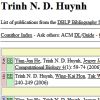   
Trinh N. D. Huynh,
Jesper Jansson,
Nguyen Bao Nguyen and
Wing-Kin Sung. Constructing a Smallest Refining Galled Phylogenetic Network. In RECOMB05, Vol. 3500:265-280 of LNCS, springer, 2005.
Keywords: from rooted trees, galled tree, NP complete, phylogenetic network, phylogeny, polynomial, Program SPNet, reconstruction.
Note: http://www.df.lth.se/~jj/Publications/refining_gn3_RECOMB2005.pdf.
|
|
| |
   
Daniel H. Huson,
Tobias Kloepper,
Peter J. Lockhart and
Mike Steel. Reconstruction of Reticulate Networks from Gene Trees. In RECOMB05, Vol. 3500:233-249 of LNCS, springer, 2005.
Keywords: from rooted trees, from splits, phylogenetic network, phylogeny, reconstruction, split, split network, visualization.
Note: http://dx.doi.org/10.1007/11415770_18.
|
|
| |
|
| |
 
Luay Nakhleh and
Li-San Wang. Phylogenetic Networks, Trees, and Clusters. In IWBRA05, Vol. 3515:919-926 of LNCS, springer, 2005.
Keywords: cluster containment, evaluation, from clusters, from network, from rooted trees, phylogenetic network, phylogeny, polynomial, tree containment, tree-child network.
Note: http://www.cs.rice.edu/~nakhleh/Papers/NakhlehWang.pdf.
|
|
| |
 
Luay Nakhleh and
Li-San Wang. Phylogenetic Networks: Properties and Relationship to Trees and Clusters. In TCSB2, Vol. 3680:82-99 of LNCS, springer, 2005.
Keywords: cluster containment, evaluation, from clusters, from network, from rooted trees, phylogenetic network, phylogeny, polynomial, tree containment, tree-child network.
Note: http://www.cs.rice.edu/~nakhleh/Papers/LNCS_TCSB05.pdf.
|
|
| |
|
| |
|
| |
  
Luay Nakhleh,
Tandy Warnow and
C. Randal Linder. Reconstructing reticulate evolution in species - theory and practice. In RECOMB04, Pages 337-346, 2004.
Keywords: from rooted trees, galled tree, phylogenetic network, phylogeny, polynomial, Program SPNet, reconstruction, software.
Note: http://www.cs.rice.edu/~nakhleh/Papers/144-nakhleh.pdf.
|
|
| |
   
Cuong Than,
Derek Ruths,
Hideki Innan and
Luay Nakhleh. Identifiability Issues in Phylogeny-Based Detection of Horizontal Gene Transfer. In Proceedings of the Fourth RECOMB Comparative Genomics Satellite Workshop (RECOMB-CG'06), Vol. 4205:215-229 of LNCS, springer, 2006.
Keywords: explicit network, from rooted trees, from species tree, lateral gene transfer, phylogenetic network, phylogeny, Program LatTrans, Program PhyloNet.
Note: http://www.cs.rice.edu/~nakhleh/Papers/recombcg06-final.pdf.
|
|
| |
|
| |
   
Bhaskar DasGupta,
Sergio Ferrarini,
Uthra Gopalakrishnan and
Nisha Raj Paryani. Inapproximability results for the lateral gene transfer problem. In Proceedings of the Ninth Italian Conference on Theoretical Computer Science (ICTCS'05), Pages 182-195, springer, 2005.
Keywords: approximation, from rooted trees, from species tree, inapproximability, lateral gene transfer, parsimony, phylogenetic network, phylogeny.
Note: http://www.cs.uic.edu/~dasgupta/resume/publ/papers/ictcs-final.pdf.
|
|
| |
  
Mike Hallett,
Jens Lagergren and
Ali Tofigh. Simultaneous Identification of Duplications and Lateral Transfers. In RECOMB04, Pages 347-356, 2004.
Keywords: duplication, explicit network, FPT, from rooted trees, from species tree, lateral gene transfer, loss, NP complete, parsimony, phylogenetic network, phylogeny, polynomial, reconstruction.
Note: http://www.nada.kth.se/~jensl/p164-hallett.pdf.
|
|
| |
 
Cuong Than and
Luay Nakhleh. SPR-based Tree Reconciliation: Non-binary Trees and Multiple Solutions. In APBC08, Pages 251-260, 2008.
Keywords: evaluation, from rooted trees, lateral gene transfer, phylogenetic network, phylogeny, Program LatTrans, Program PhyloNet, reconstruction, SPR distance.
Note: http://www.cs.rice.edu/~nakhleh/Papers/apbc08.pdf.
|
|
| |
 
Daniel H. Huson and
Regula Rupp. Summarizing Multiple Gene Trees Using Cluster Networks. In WABI08, Vol. 5251:296-305 of LNCS, springer, 2008.
Keywords: abstract network, from clusters, from rooted trees, phylogenetic network, phylogeny, polynomial, Program Dendroscope.
Note: http://dx.doi.org/10.1007/978-3-540-87361-7_25, slides from the MIEP Conference available at http://www.lirmm.fr/MIEP08/slides/11_13_rupp.pdf.
Toggle abstract
"The result of a multiple gene tree analysis is usually a number of different tree topologies that are each supported by a significant proportion of the genes. We introduce the concept of a cluster network that can be used to combine such trees into a single rooted network, which can be drawn either as a cladogram or phylogram. In contrast to split networks, which can grow exponentially in the size of the input, cluster networks grow only quadratically. A cluster network is easily computed using a modification of the tree-popping algorithm, which we call network-popping. The approach has been implemented as part of the Dendroscope tree-drawing program and its application is illustrated using data and results from three recent studies on large numbers of gene trees. © 2008 Springer-Verlag Berlin Heidelberg."
|
|
| |
  
Cuong Than,
Guohua Jin and
Luay Nakhleh. Integrating Sequence and Topology for Efficient and Accurate Detection of Horizontal Gene Transfer. In Proceedings of the Sixth RECOMB Comparative Genomics Satellite Workshop (RECOMB-CG'08), Vol. 5267:113-127 of LNCS, springer, 2008.
Keywords: bootstrap, explicit network, from rooted trees, from sequences, lateral gene transfer, phylogenetic network, phylogeny, Program Nepal, Program PhyloNet, reconstruction.
Note: http://www.cs.rice.edu/~nakhleh/Papers/recombcg-08.pdf, slides available at http://igm.univ-mlv.fr/RCG08/RCG08slides/Cuong_Than_RCG08.pdf.
|
|
| |

Pawel Górecki. Reconciliation problems for duplication, loss and horizontal gene transfer. In RECOMB04, Pages 316-325, 2004.
Keywords: duplication, explicit network, from rooted trees, from species tree, lateral gene transfer, loss, NP complete, parsimony, phylogenetic network, phylogeny, polynomial, reconstruction.
Note: http://ai.stanford.edu/~serafim/CS374_2004/Papers/Gorecki_Reconciliation.pdf.
|
|
| |

Pawel Górecki. Single step reconciliation algorithm for duplication, loss and horizontal gene transfer model. In ECCB03, 2003.
Keywords: duplication, explicit network, from rooted trees, from species tree, lateral gene transfer, NP complete, parsimony, phylogenetic network, phylogeny, polynomial, reconstruction.
Note: http://www.inra.fr/eccb2003/posters/pdf/short/S_gorecki.ps.
|
|
| |
    
Daniel H. Huson,
Regula Rupp,
Vincent Berry,
Philippe Gambette and
Christophe Paul. Computing Galled Networks from Real Data. In ISMBECCB09, Vol. 25(12):i85-i93 of BIO, 2009.
Keywords: abstract network, cluster containment, explicit network, FPT, from clusters, from rooted trees, galled network, NP complete, phylogenetic network, phylogeny, polynomial, Program Dendroscope, reconstruction.
Note: http://hal-lirmm.ccsd.cnrs.fr/lirmm-00368545/en/.
Toggle abstract
"Motivation: Developing methods for computing phylogenetic networks from biological data is an important problem posed by molecular evolution and much work is currently being undertaken in this area. Although promising approaches exist, there are no tools available that biologists could easily and routinely use to compute rooted phylogenetic networks on real datasets containing tens or hundreds of taxa. Biologists are interested in clades, i.e. groups of monophyletic taxa, and these are usually represented by clusters in a rooted phylogenetic tree. The problem of computing an optimal rooted phylogenetic network from a set of clusters, is hard, in general. Indeed, even the problem of just determining whether a given network contains a given cluster is hard. Hence, some researchers have focused on topologically restricted classes of networks, such as galled trees and level-k networks, that are more tractable, but have the practical draw-back that a given set of clusters will usually not possess such a representation. Results: In this article, we argue that galled networks (a generalization of galled trees) provide a good trade-off between level of generality and tractability. Any set of clusters can be represented by some galled network and the question whether a cluster is contained in such a network is easy to solve. Although the computation of an optimal galled network involves successively solving instances of two different NP-complete problems, in practice our algorithm solves this problem exactly on large datasets containing hundreds of taxa and many reticulations in seconds, as illustrated by a dataset containing 279 prokaryotes. © 2009 The Author(s)."
|
|
| |
|
| |
|
| |

Yufeng Wu. Close Lower and Upper Bounds for the Minimum Reticulate Network of Multiple Phylogenetic Trees. In ISMB10, Vol. 26(12):i140-i148 of BIO, 2010.
Keywords: explicit network, from rooted trees, hybridization, minimum number, phylogenetic network, phylogeny, Program PIRN, software.
Note: http://dx.doi.org/10.1093/bioinformatics/btq198.
Toggle abstract
"Motivation: Reticulate network is a model for displaying and quantifying the effects of complex reticulate processes on the evolutionary history of species undergoing reticulate evolution. A central computational problem on reticulate networks is: given a set of phylogenetic trees (each for some region of the genomes), reconstruct the most parsimonious reticulate network (called the minimum reticulate network) that combines the topological information contained in the given trees. This problem is well-known to be NP-hard. Thus, existing approaches for this problem either work with only two input trees or make simplifying topological assumptions. Results: We present novel results on the minimum reticulate network problem. Unlike existing approaches, we address the fully general problem: there is no restriction on the number of trees that are input, and there is no restriction on the form of the allowed reticulate network. We present lower and upper bounds on the minimum number of reticulation events in the minimum reticulate network (and infer an approximately parsimonious reticulate network). A program called PIRN implements these methods, which also outputs a graphical representation of the inferred network. Empirical results on simulated and biological data show that our methods are practical for a wide range of data. More importantly, the lower and upper bounds match for many datasets (especially when the number of trees is small or reticulation level is low), and this allows us to solve the minimum reticulate network problem exactly for these datasets. Availability: A software tool, PIRN, is available for download from the web page: http://www.engr.uconn.edu/ywu. Contact: ywu@engr.uconn.edu. Supplementary information: Supplementary data is available at Bioinformatics online. © The Author(s) 2010. Published by Oxford University Press."
|
|
| |

Yufeng Wu and
Jiayin Wang. Fast Computation of the Exact Hybridization Number of Two Phylogenetic Trees. In ISBRA10, Vol. 6053:203-214 of LNCS, springer, 2010.
Keywords: agreement forest, explicit network, from rooted trees, hybridization, integer linear programming, minimum number, phylogenetic network, phylogeny, Program HybridNumber, Program SPRDist, SPR distance.
Note: http://www.engr.uconn.edu/~ywu/Papers/ISBRA10WuWang.pdf.
Toggle abstract
"Hybridization is a reticulate evolutionary process. An established problem on hybridization is computing the minimum number of hybridization events, called the hybridization number, needed in the evolutionary history of two phylogenetic trees. This problem is known to be NP-hard. In this paper, we present a new practical method to compute the exact hybridization number. Our approach is based on an integer linear programming formulation. Simulation results on biological and simulated datasets show that our method (as implemented in program SPRDist) is more efficient and robust than an existing method. © 2010 Springer-Verlag Berlin Heidelberg."
|
|
| |
  
Mukul S. Bansal,
J. Peter Gogarten and
Ron Shamir. Detecting Highways of Horizontal Gene Transfer. In Proceedings of the Eighth RECOMB Comparative Genomics Satellite Workshop (RECOMB-CG'10), Vol. 6398:109-120 of LNCS, springer, 2011.
Keywords: explicit network, from rooted trees, from species tree, lateral gene transfer, phylogenetic network, phylogeny, polynomial, reconstruction.
Note: http://www.cs.iastate.edu/~bansal/Highways_RCG10.pdf.
Toggle abstract
"In a horizontal gene transfer (HGT) event a gene is transferred between two species that do not share an ancestor-descendant relationship. Typically, no more than a few genes are horizontally transferred between any two species. However, several studies identified pairs of species between which many different genes were horizontally transferred. Such a pair is said to be linked by a highway of gene sharing. We present a method for inferring such highways. Our method is based on the fact that the evolutionary histories of horizontally transferred genes disagree with the corresponding species phylogeny. Specifically, given a set of gene trees and a trusted rooted species tree, each gene tree is first decomposed into its constituent quartet trees and the quartets that are inconsistent with the species tree are identified. Our method finds a pair of species such that a highway between them explains the largest (normalized) fraction of inconsistent quartets. For a problem on n species, our method requires O(n 4) time, which is optimal with respect to the quartets input size. An application of our method to a dataset of 1128 genes from 11 cyanobacterial species, as well as to simulated datasets, illustrates the efficacy of our method. © 2010 Springer-Verlag."
|
|
| |
|
| |
  
Chris Whidden,
Robert G. Beiko and
Norbert Zeh. Fast FPT Algorithms for Computing Rooted Agreement Forests: Theory and Experiments. In Proceedings of the ninth International Symposium on Experimental Algorithms (SEA'10), Vol. 6049:141-153 of LNCS, springer, 2010.
Keywords: agreement forest, explicit network, FPT, from rooted trees, hybridization, minimum number, phylogenetic network, phylogeny, Program HybridInterleave, reconstruction, SPR distance.
Note: https://www.cs.dal.ca/sites/default/files/technical_reports/CS-2010-03.pdf.
Toggle abstract
"We improve on earlier FPT algorithms for computing a rooted maximum agreement forest (MAF) or a maximum acyclic agreement forest (MAAF) of a pair of phylogenetic trees. Their sizes give the subtree-prune-and-regraft (SPR) distance and the hybridization number of the trees, respectively. We introduce new branching rules that reduce the running time of the algorithms from O(3 kn) and O(3 kn log n) to O(2.42 kn) and O(2.42 kn log n), respectively. In practice, the speed up may be much more than predicted by the worst-case analysis.We confirm this intuition experimentally by computing MAFs for simulated trees and trees inferred from protein sequence data. We show that our algorithm is orders of magnitude faster and can handle much larger trees and SPR distances than the best previous methods, treeSAT and sprdist. © Springer-Verlag Berlin Heidelberg 2010."
|
|
| |
  
Mukul S. Bansal,
Eric J. Alm and
Manolis Kellis. Efficient Algorithms for the Reconciliation Problem with Gene Duplication, Horizontal Transfer, and Loss. In ISMB12, Vol. 28(12):i283-i291 of BIO, 2012.
Keywords: duplication, explicit network, from rooted trees, from species tree, lateral gene transfer, loss, phylogenetic network, phylogeny, Program Angst, Program Mowgli, Program RANGER-DTL, reconstruction.
Note: http://dx.doi.org/10.1093/bioinformatics/bts225.
Toggle abstract
"Motivation: Gene family evolution is driven by evolutionary events such as speciation, gene duplication, horizontal gene transfer and gene loss, and inferring these events in the evolutionary history of a given gene family is a fundamental problem in comparative and evolutionary genomics with numerous important applications. Solving this problem requires the use of a reconciliation framework, where the input consists of a gene family phylogeny and the corresponding species phylogeny, and the goal is to reconcile the two by postulating speciation, gene duplication, horizontal gene transfer and gene loss events. This reconciliation problem is referred to as duplication-transfer-loss (DTL) reconciliation and has been extensively studied in the literature. Yet, even the fastest existing algorithms for DTL reconciliation are too slow for reconciling large gene families and for use in more sophisticated applications such as gene tree or species tree reconstruction.Results: We present two new algorithms for the DTL reconciliation problem that are dramatically faster than existing algorithms, both asymptotically and in practice. We also extend the standard DTL reconciliation model by considering distance-dependent transfer costs, which allow for more accurate reconciliation and give an efficient algorithm for DTL reconciliation under this extended model. We implemented our new algorithms and demonstrated up to 100 000-fold speed-up over existing methods, using both simulated and biological datasets. This dramatic improvement makes it possible to use DTL reconciliation for performing rigorous evolutionary analyses of large gene families and enables its use in advanced reconciliation-based gene and species tree reconstruction methods. © The Author(s) 2012. Published by Oxford University Press."
|
|
| |
   
Leo van Iersel,
Steven Kelk,
Nela Lekic and
Celine Scornavacca. A practical approximation algorithm for solving massive instances of hybridization number. In WABI12, Vol. 7534(430-440) of LNCS, springer, 2012.
Keywords: agreement forest, approximation, explicit network, from rooted trees, hybridization, phylogenetic network, phylogeny, Program CycleKiller, Program Dendroscope, Program HybridNET, reconstruction, software.
Note: http://arxiv.org/abs/1205.3417.
Toggle abstract
"Reticulate events play an important role in determining evolutionary relationships. The problem of computing the minimum number of such events to explain discordance between two phylogenetic trees is a hard computational problem. In practice, exact solvers struggle to solve instances with reticulation number larger than 40. For such instances, one has to resort to heuristics and approximation algorithms. Here we present the algorithm CycleKiller which is the first approximation algorithm that can produce solutions verifiably close to optimality for instances with hundreds or even thousands of reticulations. Theoretically, the algorithm is an exponential-time 2-approximation (or 4-approximation in its fastest mode). However, using simulations we demonstrate that in practice the algorithm runs quickly for large and difficult instances, producing solutions within one percent of optimality. An implementation of this algorithm, which extends the theoretical work of [14], has been made publicly available. © 2012 Springer-Verlag."
|
|
| |
    
Maureen Stolzer,
Han Lai,
Minli Xu,
Deepa Sathaye,
Benjamin Vernot and
Dannie Durand. Inferring Duplications, Losses, Transfers, and Incomplete Lineage Sorting with Non-Binary Species Trees. In ECCB12, Vol. 28(18):i409-i415 of BIO, 2012.
Keywords: duplication, explicit network, from rooted trees, lateral gene transfer, loss, phylogenetic network, phylogeny, Program Notung, reconstruction.
Note: http://dx.doi.org/10.1093/bioinformatics/bts386.
Toggle abstract
"Motivation: Gene duplication (D), transfer (T), loss (L) and incomplete lineage sorting (I) are crucial to the evolution of gene families and the emergence of novel functions.The history of these events can be inferred via comparison of gene and species trees, a process called reconciliation, yet current reconciliation algorithms model only a subset of these evolutionary processes. Results: We present an algorithm to reconcile a binary gene tree with a nonbinary species tree under a DTLI parsimony criterion. This is the first reconciliation algorithm to capture all four evolutionary processes driving tree incongruence and the first to reconcile nonbinary species trees with a transfer model. Our algorithm infers all optimal solutions and reports complete, temporally feasible event histories, giving the gene and species lineages in which each event occurred. It is fixed-parameter tractable, with polytime complexity when the maximum species outdegree is fixed. Application of our algorithms to prokaryotic and eukaryotic data show that use of an incomplete event model has substantial impact on the events inferred and resulting biological conclusions. © The Author(s) 2012. Published by Oxford University Press."
|
|
| |

Yufeng Wu. An Algorithm for Constructing Parsimonious Hybridization Networks with Multiple Phylogenetic Trees. In RECOMB13, Vol. 7821:291-303 of LNCS, springer, 2013.
Keywords: explicit network, exponential algorithm, from rooted trees, phylogenetic network, phylogeny, Program PIRN, reconstruction.
Note: http://www.engr.uconn.edu/~ywu/Papers/ExactNetRecomb2013.pdf.
Toggle abstract
"Phylogenetic network is a model for reticulate evolution. Hybridization network is one type of phylogenetic network for a set of discordant gene trees, and "displays" each gene tree. A central computational problem on hybridization networks is: given a set of gene trees, reconstruct the minimum (i.e. most parsimonious) hybridization network that displays each given gene tree. This problem is known to be NP-hard, and existing approaches for this problem are either heuristics or make simplifying assumptions (e.g. work with only two input trees or assume some topological properties). In this paper, we develop an exact algorithm (called PIRNC ) for inferring the minimum hybridization networks from multiple gene trees. The PIRNC algorithm does not rely on structural assumptions. To the best of our knowledge, PIRN C is the first exact algorithm for this formulation. When the number of reticulation events is relatively small (say four or fewer), PIRNC runs reasonably efficient even for moderately large datasets. For building more complex networks, we also develop a heuristic version of PIRNC called PIRNCH. Simulation shows that PIRNCH usually produces networks with fewer reticulation events than those by an existing method. © 2013 Springer-Verlag."
|
|
| |
  
Mukul S. Bansal,
Eric J. Alm and
Manolis Kellis. Reconciliation Revisited: Handling Multiple Optima when Reconciling with Duplication, Transfer, and Loss. In RECOMB13, Vol. 7821:1-13 of LNCS, springer, 2013.
Keywords: duplication, from rooted trees, from species tree, loss, phylogenetic network, phylogeny, polynomial, Program RANGER-DTL, reconstruction.
Note: http://people.csail.mit.edu/mukul/Bansal_RECOMB2013.pdf.
Toggle abstract
"Phylogenetic tree reconciliation is a powerful approach for inferring evolutionary events like gene duplication, horizontal gene transfer, and gene loss, which are fundamental to our understanding of molecular evolution. While Duplication-Loss (DL) reconciliation leads to a unique maximum-parsimony solution, Duplication-Transfer-Loss (DTL) reconciliation yields a multitude of optimal solutions, making it difficult the infer the true evolutionary history of the gene family. Here, we present an effective, efficient, and scalable method for dealing with this fundamental problem in DTL reconciliation. Our approach works by sampling the space of optimal reconciliations uniformly at random and aggregating the results. We present an algorithm to efficiently sample the space of optimal reconciliations uniformly at random in O(mn 2) time, where m and n denote the number of genes and species, respectively. We use these samples to understand how different optimal reconciliations vary in their node mapping and event assignments, and to investigate the impact of varying event costs. © 2013 Springer-Verlag."
|
|
| |
     
Hoa Vu,
Francis Chin,
Wing-Kai Hon,
Henry Leung,
Kunihiko Sadakane,
Wing-Kin Sung and
Siu-Ming Yiu. Reconstructing k-Reticulated Phylogenetic Network from a Set of Gene Trees. In ISBRA13, Vol. 7875:112-124 of LNCS, springer, 2013.
Keywords: from rooted trees, k-reticulated, phylogenetic network, phylogeny, polynomial, Program ARTNET, Program CMPT, reconstruction.
Note: http://grid.cs.gsu.edu/~xguo9/publications/2013_Cloud%20computing%20for%20de%20novo%20metagenomic%20sequence%20assembly.pdf#page=123.
Toggle abstract
"The time complexity of existing algorithms for reconstructing a level-x phylogenetic network increases exponentially in x. In this paper, we propose a new classification of phylogenetic networks called k-reticulated network. A k-reticulated network can model all level-k networks and some level-x networks with x > k. We design algorithms for reconstructing k-reticulated network (k = 1 or 2) with minimum number of hybrid nodes from a set of m binary trees, each with n leaves in O(mn 2) time. The implication is that some level-x networks with x > k can now be reconstructed in a faster way. We implemented our algorithm (ARTNET) and compared it with CMPT. We show that ARTNET outperforms CMPT in terms of running time and accuracy. We also consider the case when there does not exist a 2-reticulated network for the input trees. We present an algorithm computing a maximum subset of the species set so that a new set of subtrees can be combined into a 2-reticulated network. © 2013 Springer-Verlag."
|
|
| |
 
Leo van Iersel and
Steven Kelk. Kernelizations for the hybridization number problem on multiple nonbinary trees. In WG14, Vol. 8747:299-311 of LNCS, springer, 2014.
Keywords: explicit network, from rooted trees, kernelization, minimum number, phylogenetic network, phylogeny, Program Treeduce, reconstruction.
Note: http://arxiv.org/abs/1311.4045.
|
|
| |
|
| |
|
| |
   
Louxin Zhang,
Yen Kaow Ng,
Taoyang Wu and
Yu Zheng. Network model and efficient method for detecting relative duplications or horizontal gene transfers. In ICCABS11, Pages 214-219, 2011.
Keywords: dynamic programming, explicit network, from network, from rooted trees, from species tree, phylogenetic network, phylogeny, polynomial, reconstruction.
Toggle abstract
"Background: Horizontal gene transfer and gene duplication are two significant forces behind genome evolution. As more and more well-supported examples of HGTs are being revealed, there is a growing awareness that HGT is more widespread than previously thought, occurring often not only within bacteria, but also between species remotely related such as bacteria and plants or plants and animals. Although a substantial number of genomic sequences are known, HGT inference remains challenging. Parsimony-based inferences of HGT events are typically NP-hard under the framework of gene tree and species tree comparison; it is even more timeconsuming if the maximum likelihood approach is used. The fact that gene tree and species tree incongruence can be further confounded by gene duplication and gene loss events motivates us to incorporate considerations for these events into our inference of HGT events. Similarly, it will be beneficial if known HGT events are considered in the inference of gene duplications and gene losses. © 2011 IEEE."
|
|
| |
    
Philippe Gambette,
Andreas Gunawan,
Anthony Labarre,
Stéphane Vialette and
Louxin Zhang. Locating a Tree in A Phylogenetic Network in Quadratic Time. In RECOMB15, Vol. 9029:96-107 of LNCS, Springer, 2015.
Keywords: evaluation, explicit network, from network, from rooted trees, genetically stable network, nearly-stable network, phylogenetic network, phylogeny, polynomial, tree containment.
Note: https://hal.archives-ouvertes.fr/hal-01116231/en.
|
|
| |
|
| |
  
Jittat Fakcharoenphol,
Tanee Kumpijit and
Attakorn Putwattana. A Faster Algorithm for the Tree Containment Problem for Binary Nearly Stable Phylogenetic Networks. In Proceedings of the The 12th International Joint Conference on Computer Science and Software Engineering (JCSSE'15), Pages 337-342, IEEE, 2015.
Keywords: dynamic programming, explicit network, from network, from rooted trees, nearly-stable network, phylogenetic network, phylogeny, polynomial, tree containment.
|
|
| |
  
Andreas Gunawan,
Bhaskar DasGupta and
Louxin Zhang. Locating a Tree in a Reticulation-Visible Network in Cubic Time. In RECOMB16, Vol. 9649:266 of LNBI, Springer, 2016.
Keywords: cluster containment, explicit network, from clusters, from network, from rooted trees, phylogenetic network, phylogeny, polynomial, reticulation-visible network, tree containment.
Note: http://arxiv.org/abs/1507.02119.
|
|
| |
 
Misagh Kordi and
Mukul S. Bansal. On the Complexity of Duplication-Transfer-Loss Reconciliation with Non-Binary Gene Trees. In ISBRA15, Vol. 9096:187-198 of LNCS, springer, 2015.
Keywords: duplication, from rooted trees, from species tree, lateral gene transfer, loss, NP complete, phylogenetic network, phylogeny, reconstruction.
Note: http://compbio.engr.uconn.edu/papers/Kordi_ISBRA2015.pdf.
|
|
| |
    
Philippe Gambette,
Andreas Gunawan,
Anthony Labarre,
Stéphane Vialette and
Louxin Zhang. Solving the Tree Containment Problem for Genetically Stable Networks in Quadratic Time. In IWOCA15, Vol. 9538:197-208 of LNCS, springer, 2016.
Keywords: explicit network, from network, from rooted trees, genetically stable network, phylogenetic network, phylogeny, polynomial, tree containment.
Note: https://hal-upec-upem.archives-ouvertes.fr/hal-01226035 .
|
|
| |
 
Yun Yu and
Luay Nakhleh. A maximum pseudo-likelihood approach for phylogenetic networks. In RECOMB-CG15, Vol. 16(Suppl 10)(S10):1-10 of BMC Genomics, BioMed Central, 2015.
Keywords: explicit network, from rooted trees, hybridization, incomplete lineage sorting, likelihood, phylogenetic network, phylogeny, Program PhyloNet, reconstruction, tripartition distance.
Note: http://dx.doi.org/10.1186/1471-2164-16-S10-S10.
|
|
| |
|
| |
|
| |

Mathias Weller. Linear-Time Tree Containment in Phylogenetic Networks. In RECOMB-CG18, Vol. 11183:309-323 of LNCS, Springer, 2018.
Keywords: explicit network, from network, from rooted trees, nearly-stable network, phylogenetic network, phylogeny, polynomial, reconstruction, reticulation-visible network, tree containment.
Note: https://arxiv.org/abs/1702.06364.
|
|
| |
   
Hussein A. Hejase,
Natalie VandePol,
Gregory A. Bonito and
Kevin J. Liu. Fast and accurate statistical inference of phylogenetic networks using large-scale genomic sequence data. In RECOMB-CG18, Vol. 11183:242-259 of LNCS, Springer, 2018.
Keywords: explicit network, from rooted trees, heuristic, phylogenetic network, phylogeny, Program FastNet, reconstruction.
Note: http://biorxiv.org/content/early/2017/05/01/132795.
|
|
| |

Andreas Gunawan. Solving the Tree Containment Problem for Reticulation-visible Networks in Linear Time. In AlCoB18, Vol. 10849:24-36 of LNCS, Springer, 2018.
Keywords: explicit network, from network, from rooted trees, phylogenetic network, phylogeny, polynomial, reticulation-visible network, tree containment.
Note: https://arxiv.org/abs/1702.04088.
|
|
| |
  
Han Lai,
Maureen Stolzer and
Dannie Durand. Fast Heuristics for Resolving Weakly Supported Branches Using Duplication, Transfers, and Losses. In RECOMB-CG17, Vol. 10562:298-320 of LNCS, Springer, 2017.
Keywords: duplication, explicit network, from rooted trees, from species tree, lateral gene transfer, loss, phylogenetic network, phylogeny, Program Notung, reconstruction.
|
|
| |
 
Juan Wang and
Maozu Guo. IGNet: Constructing Rooted Phylogenetic Networks Based on Incompatible Graphs. In ICNC-FSKD19, Vol. 1075:894-900 of Advances in Intelligent Systems and Computing, Springer, 2019.
Keywords: explicit network, from rooted trees, phylogenetic network, phylogeny, Program BIMLR, Program IGNet, Program LNetwork, reconstruction, software.
|
|
|
|
 - forked on GitHub.
- forked on GitHub.




















































































































